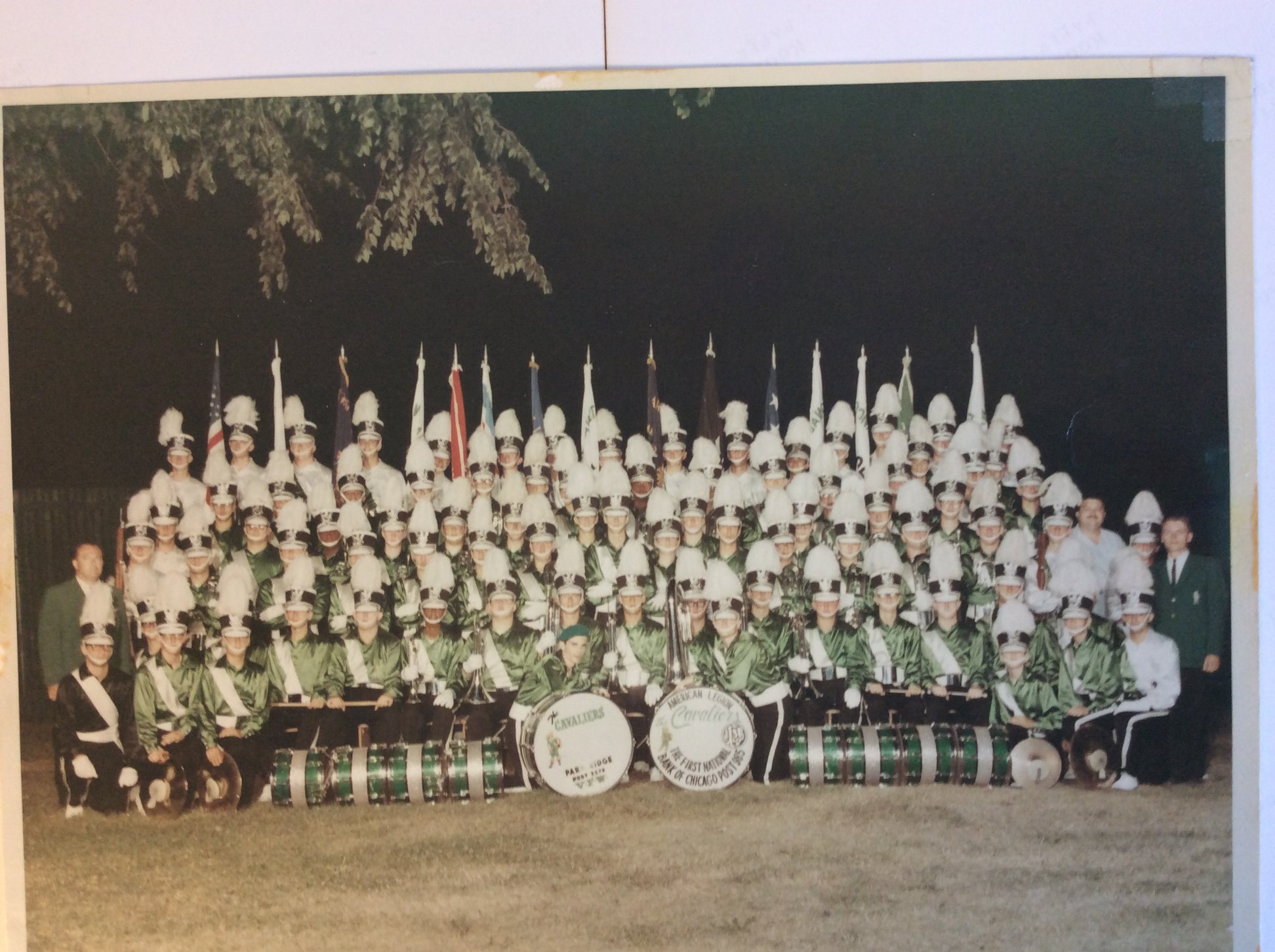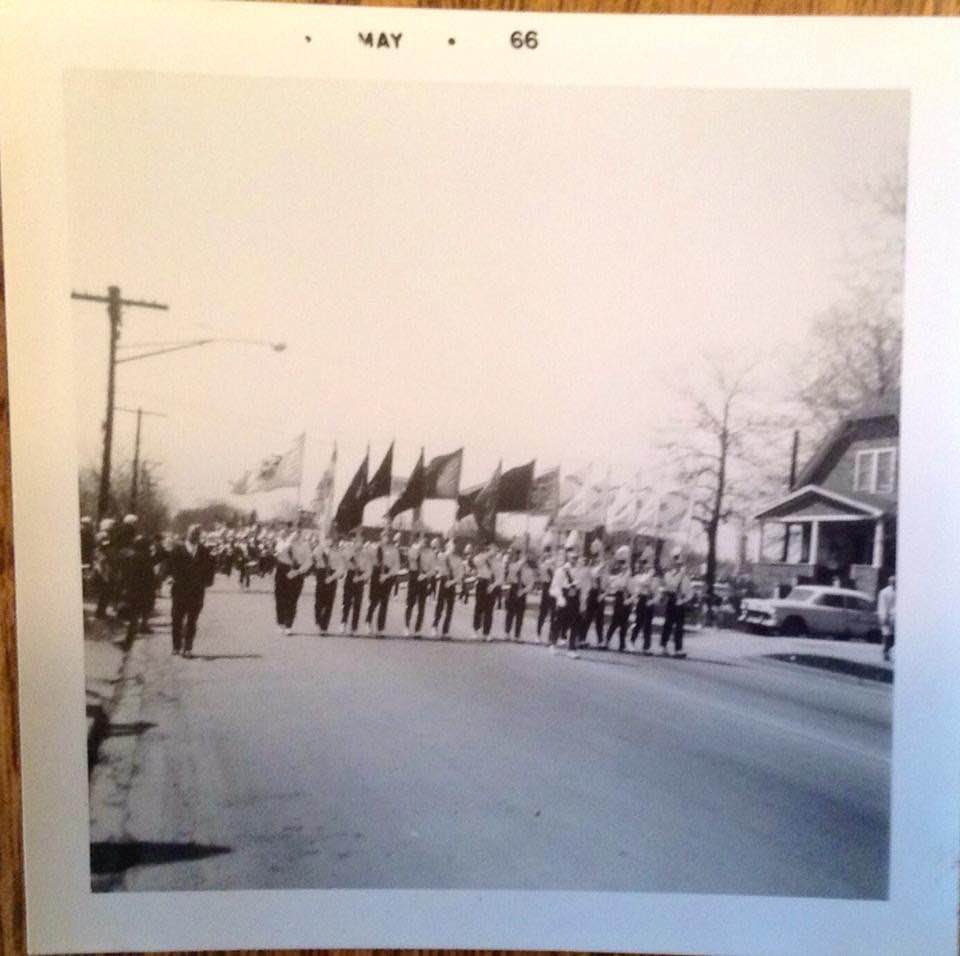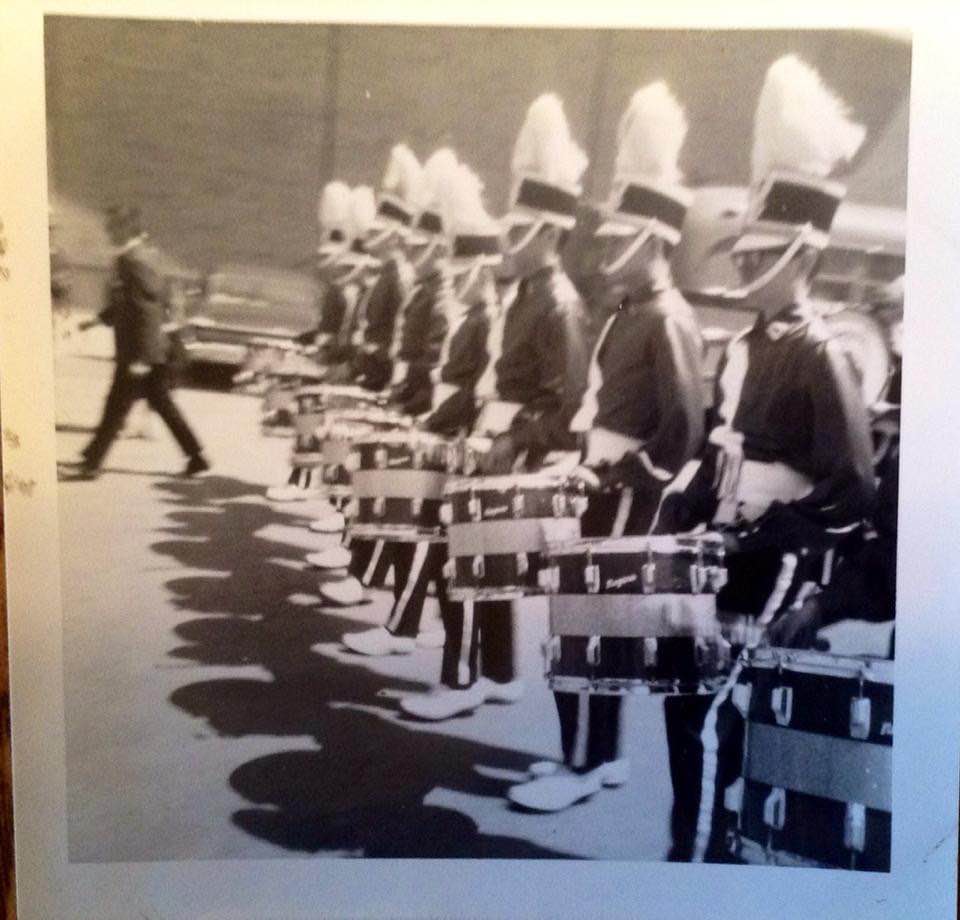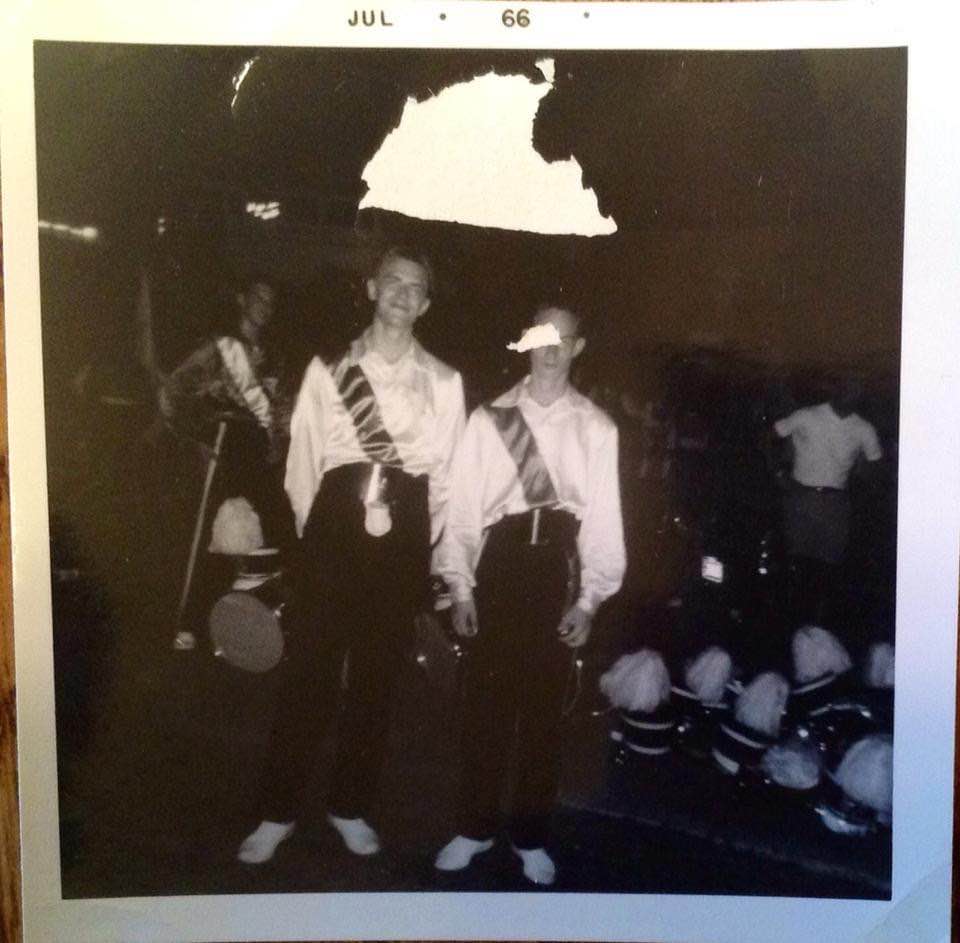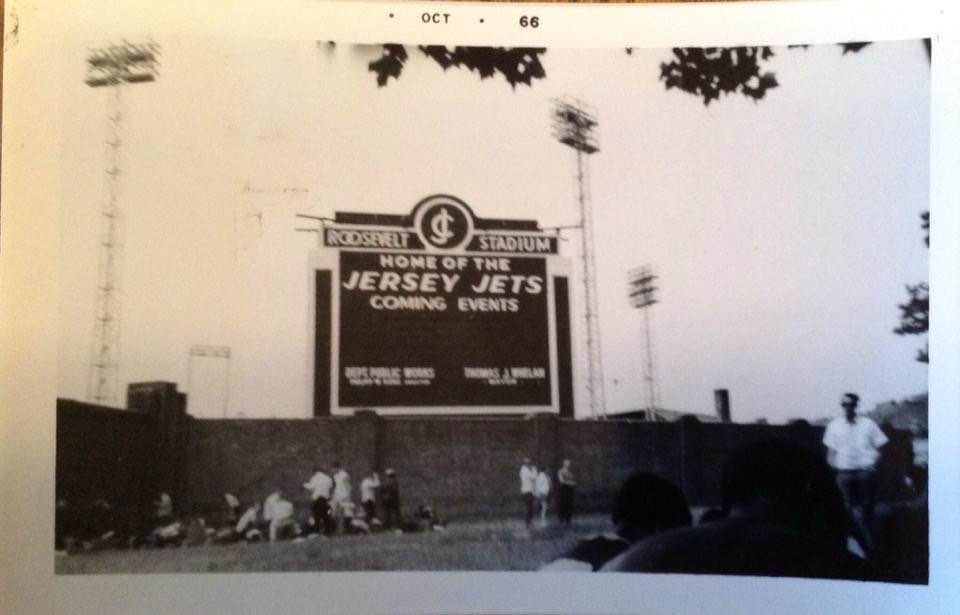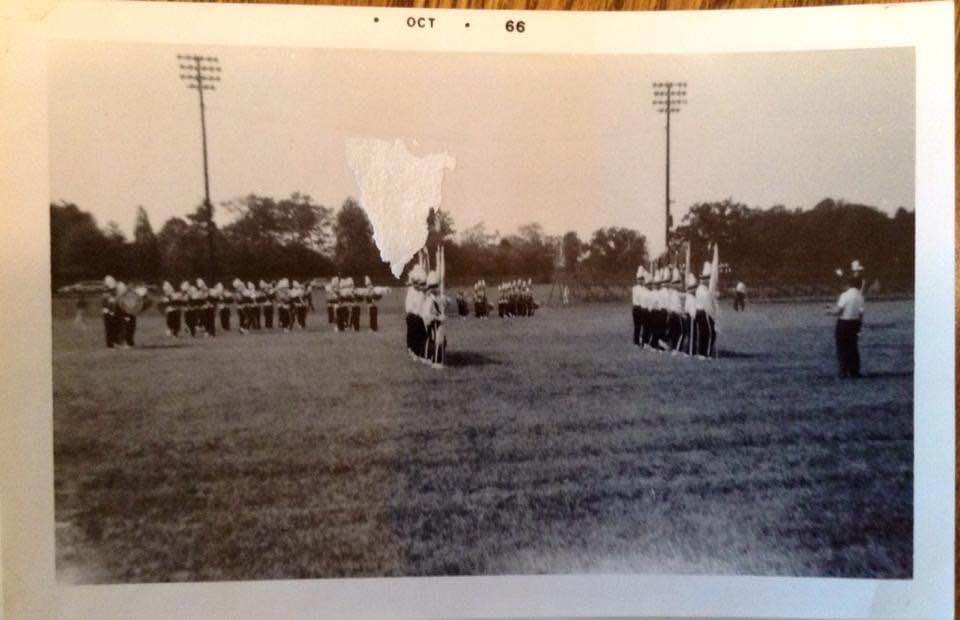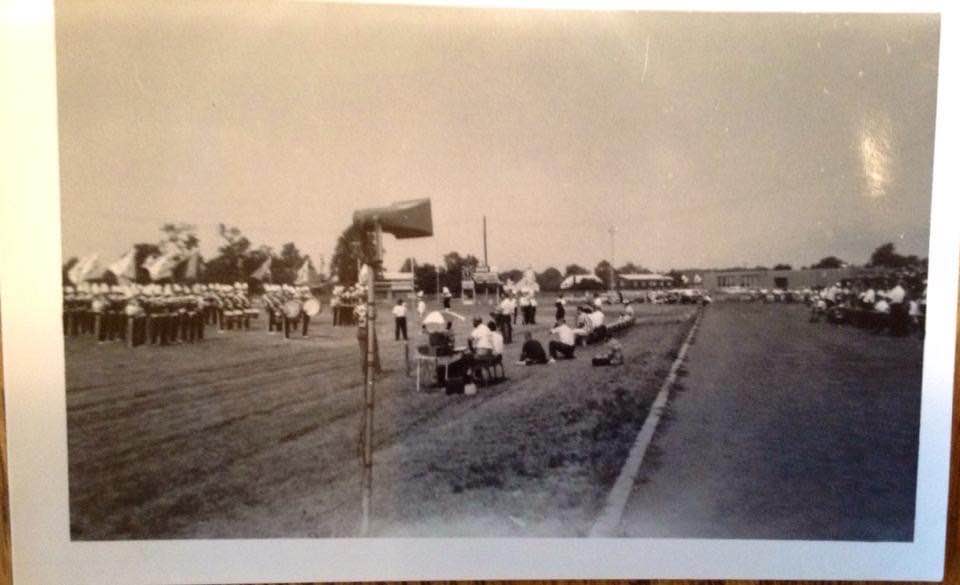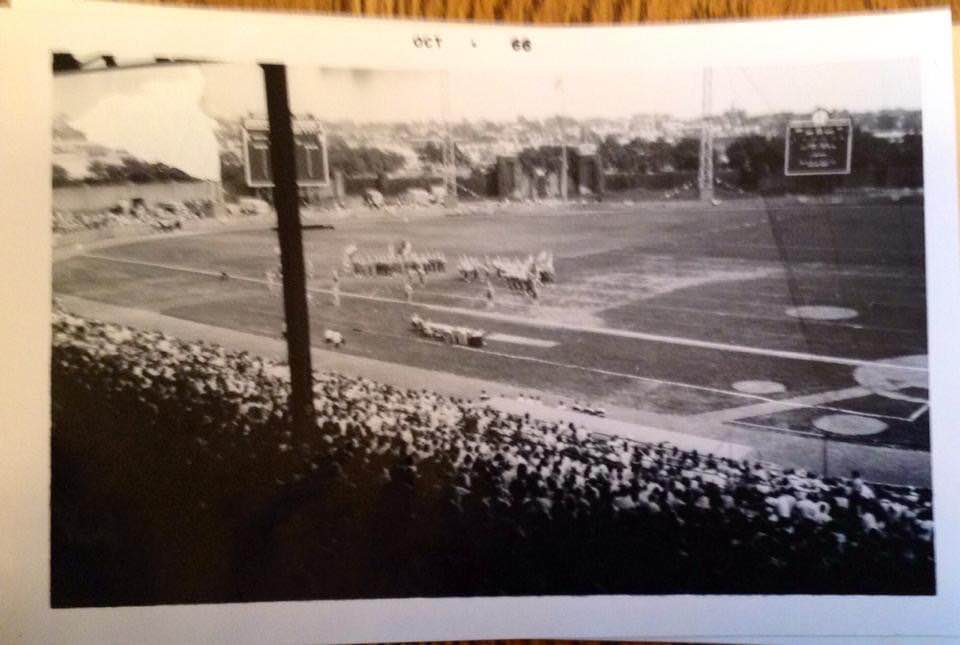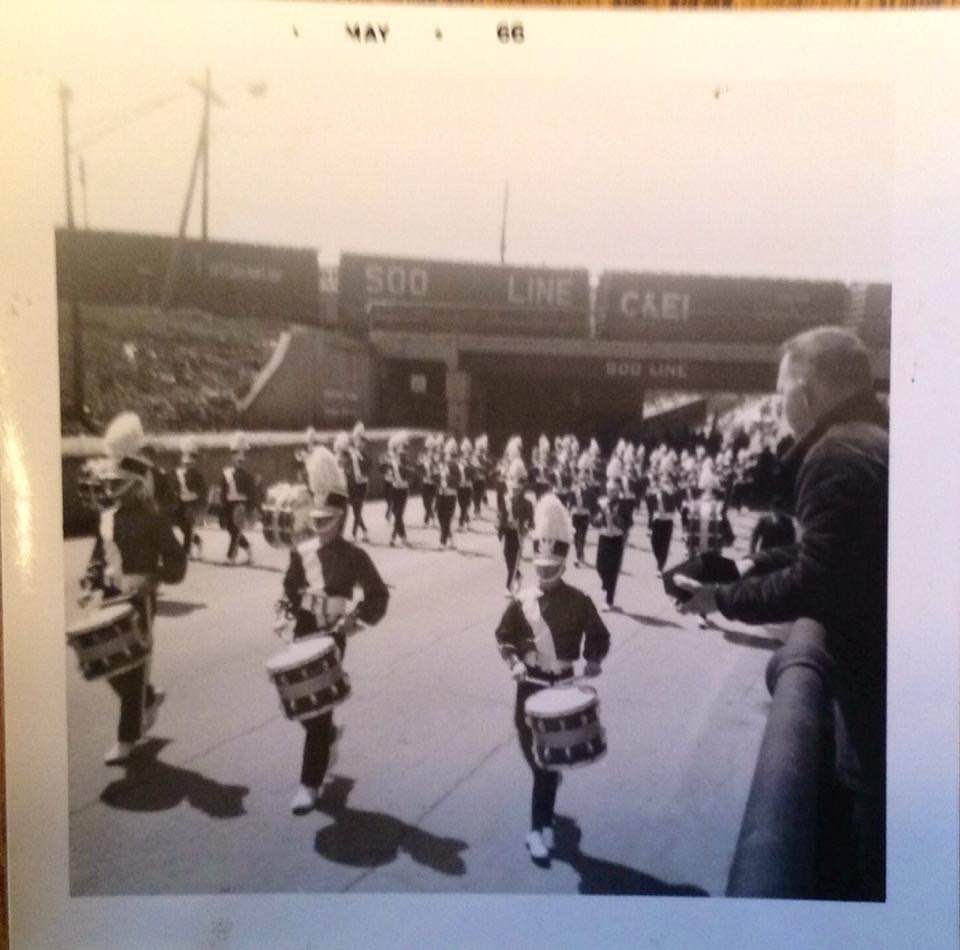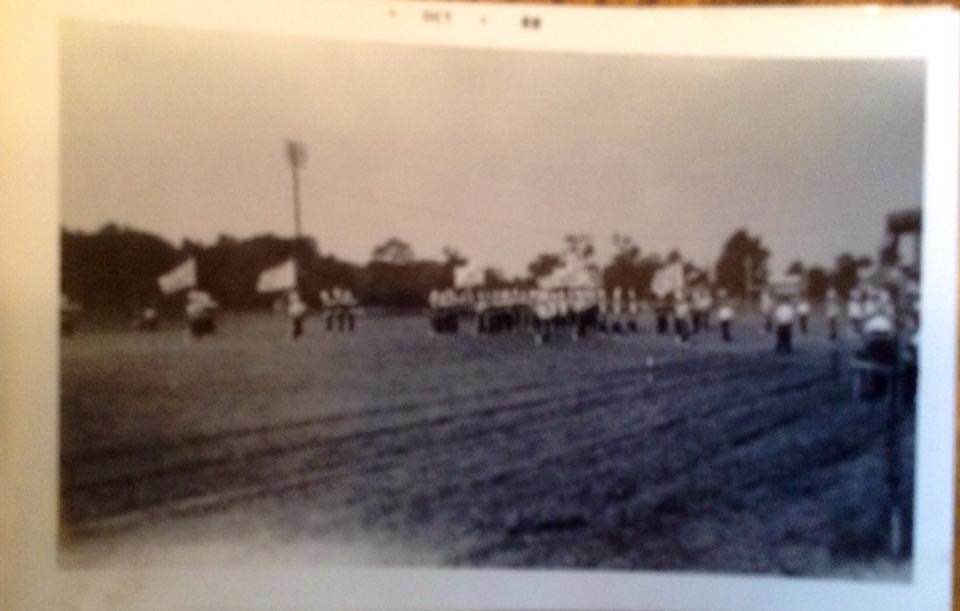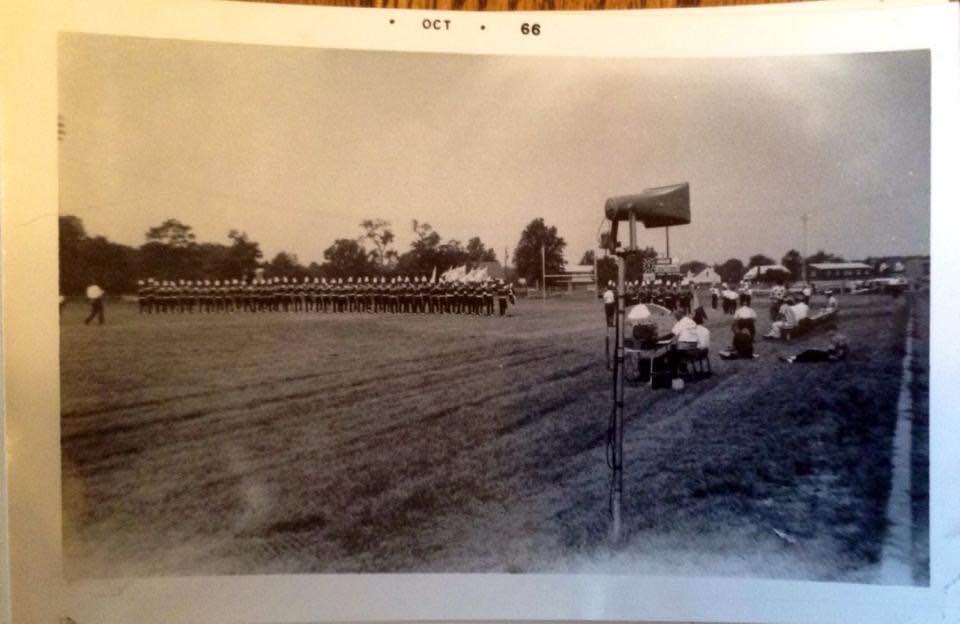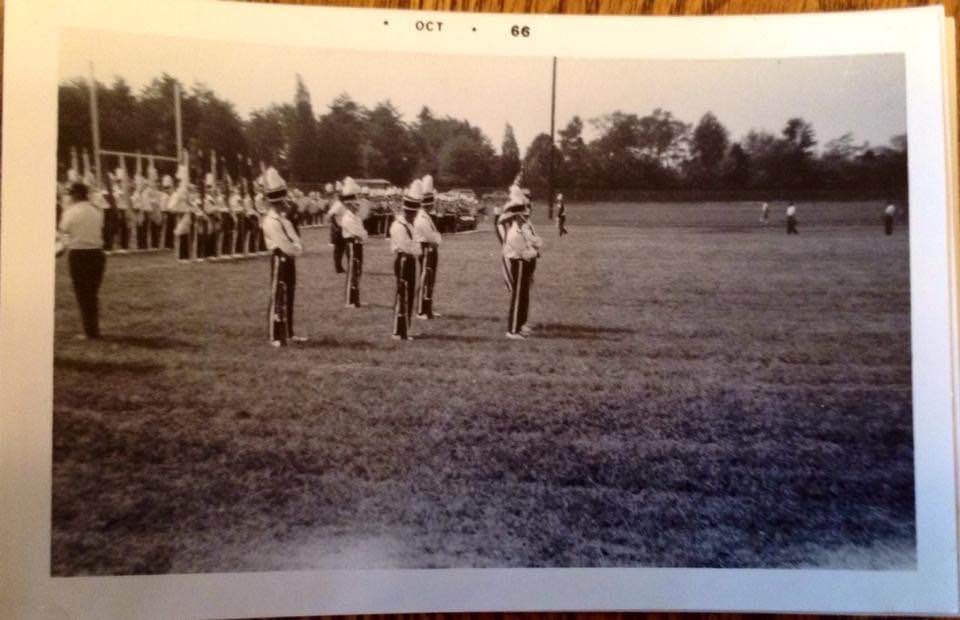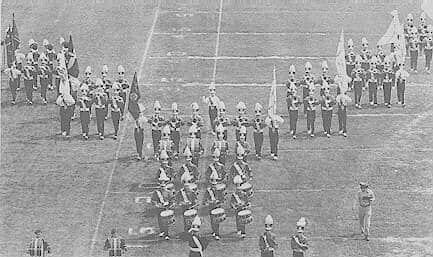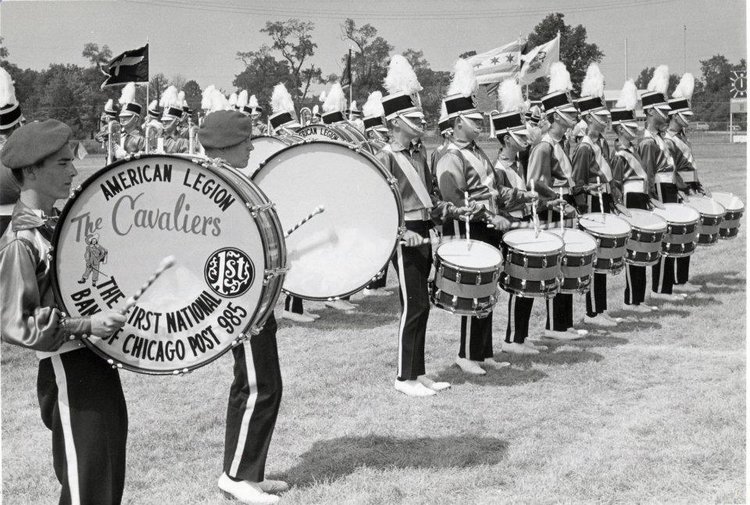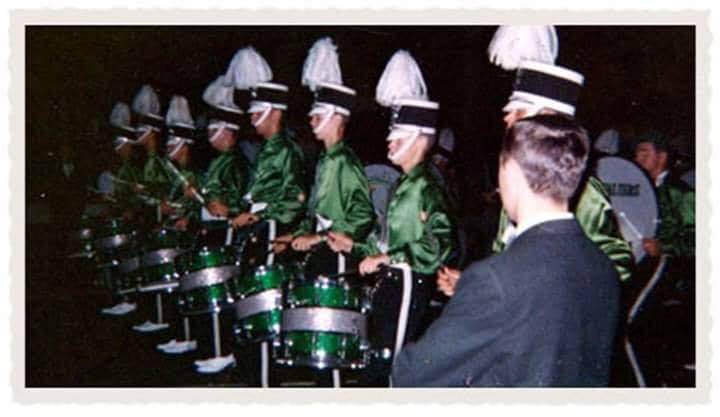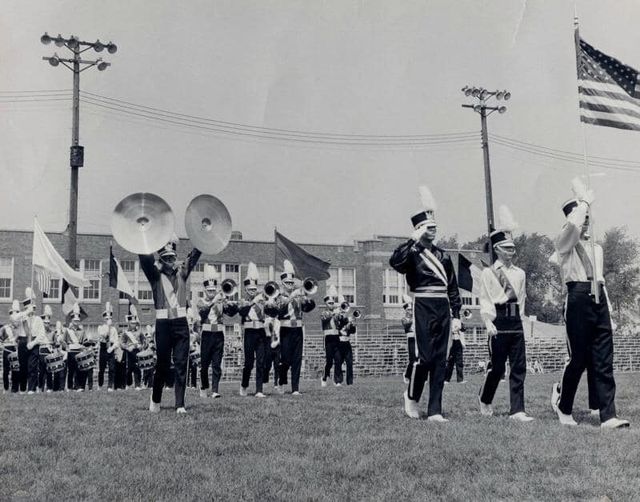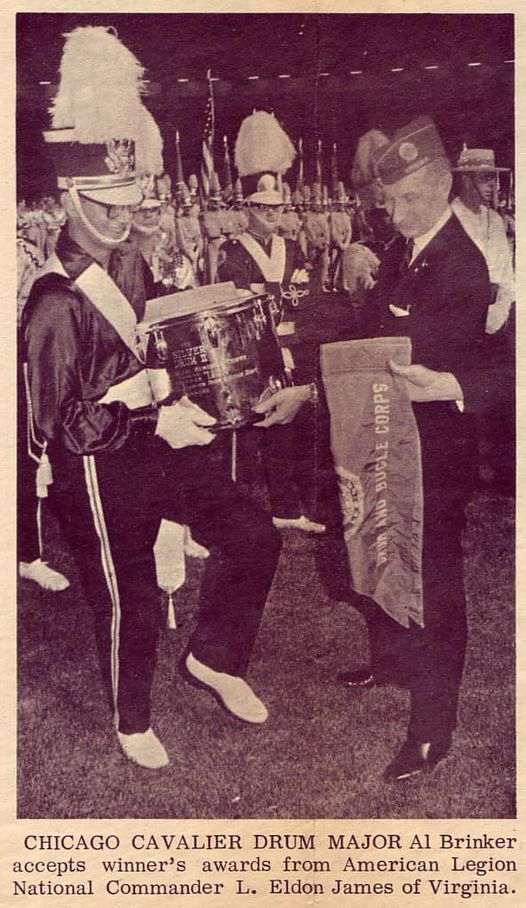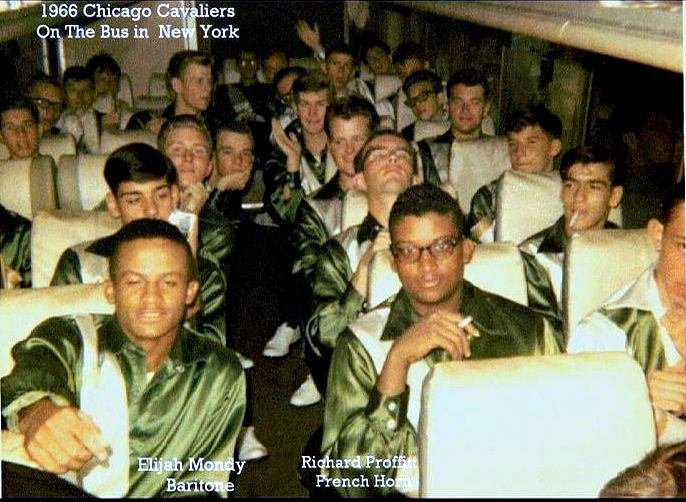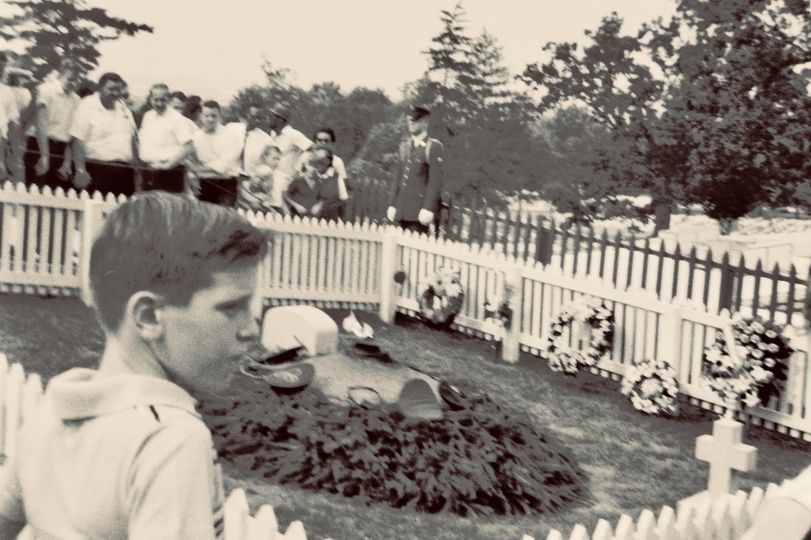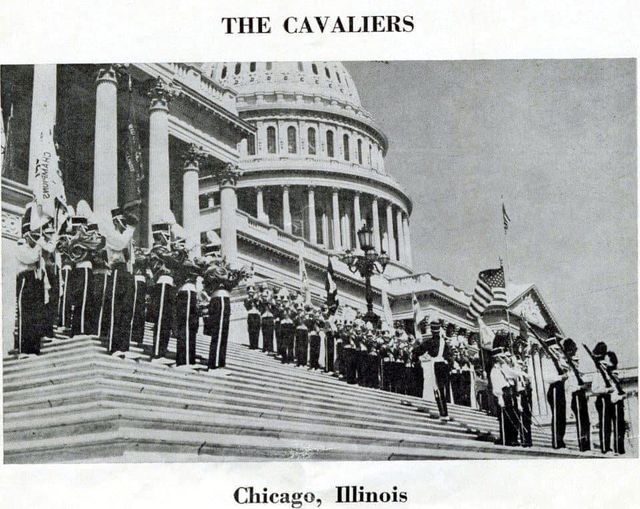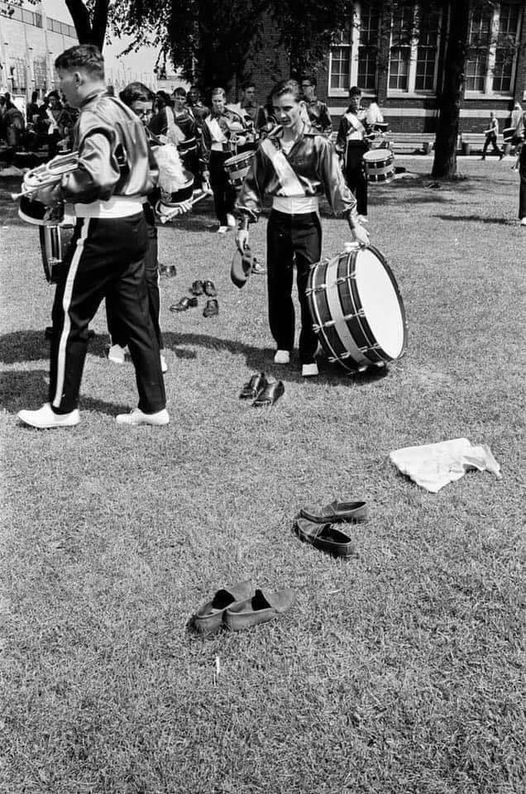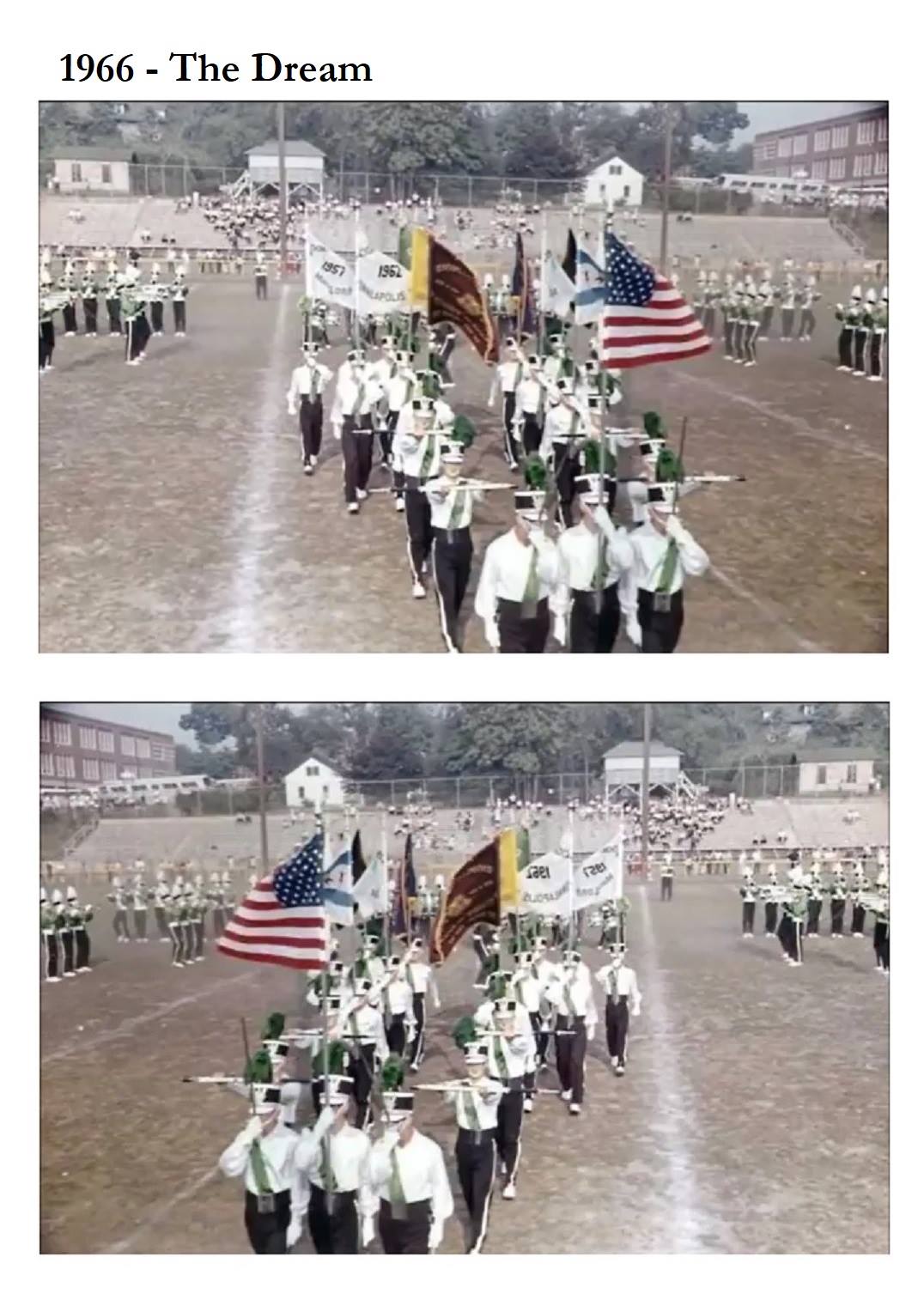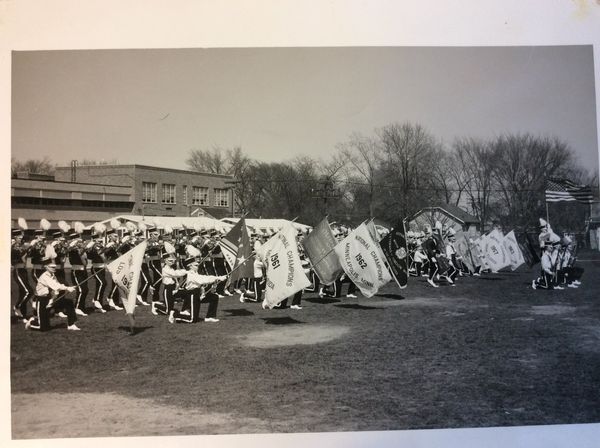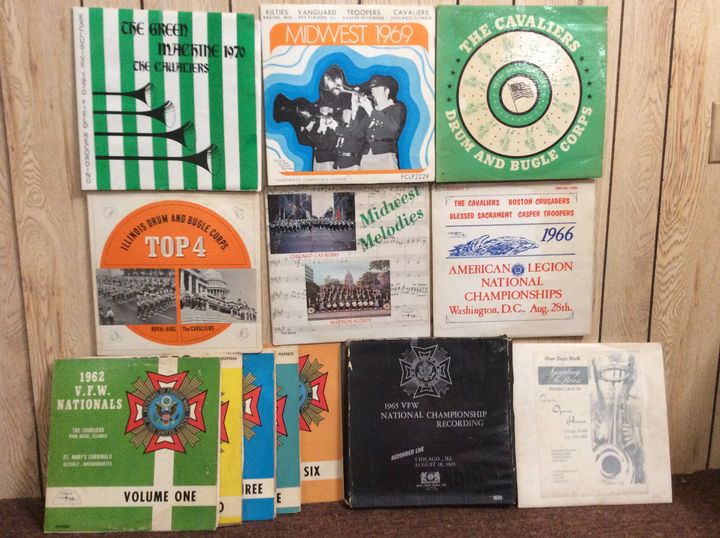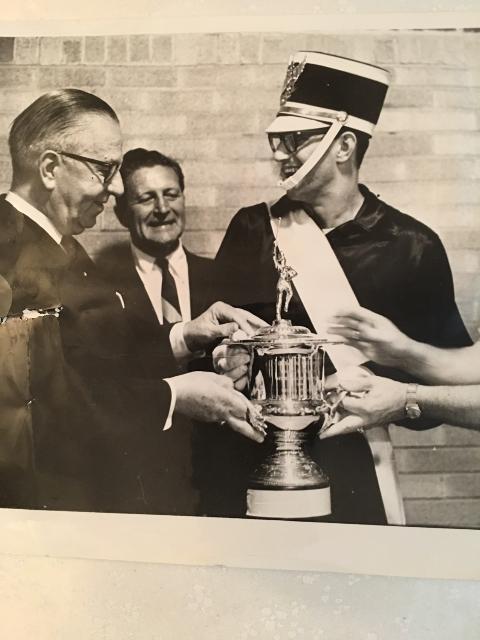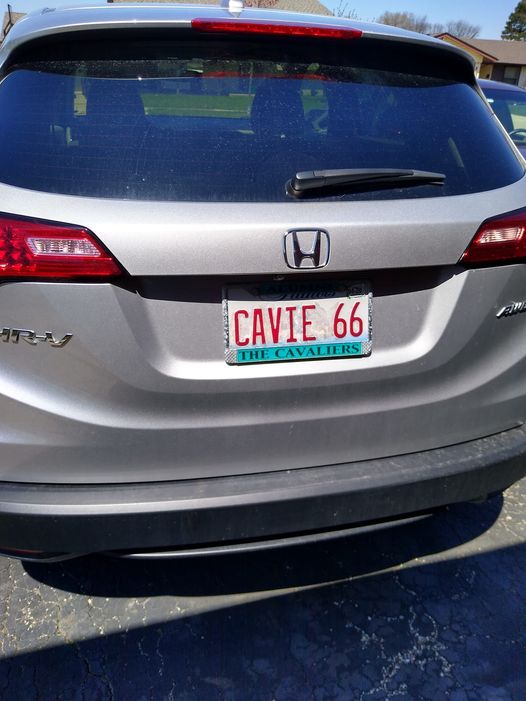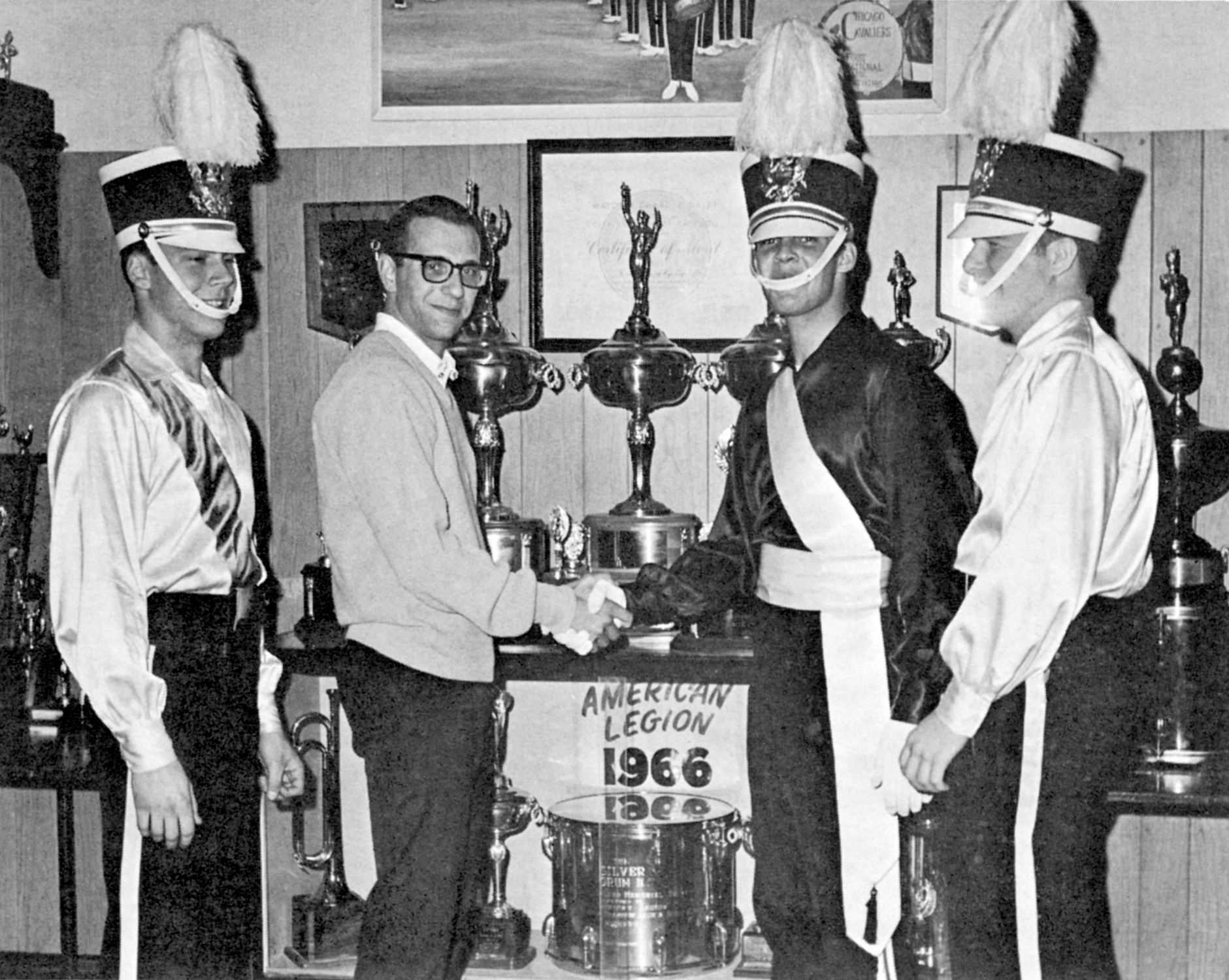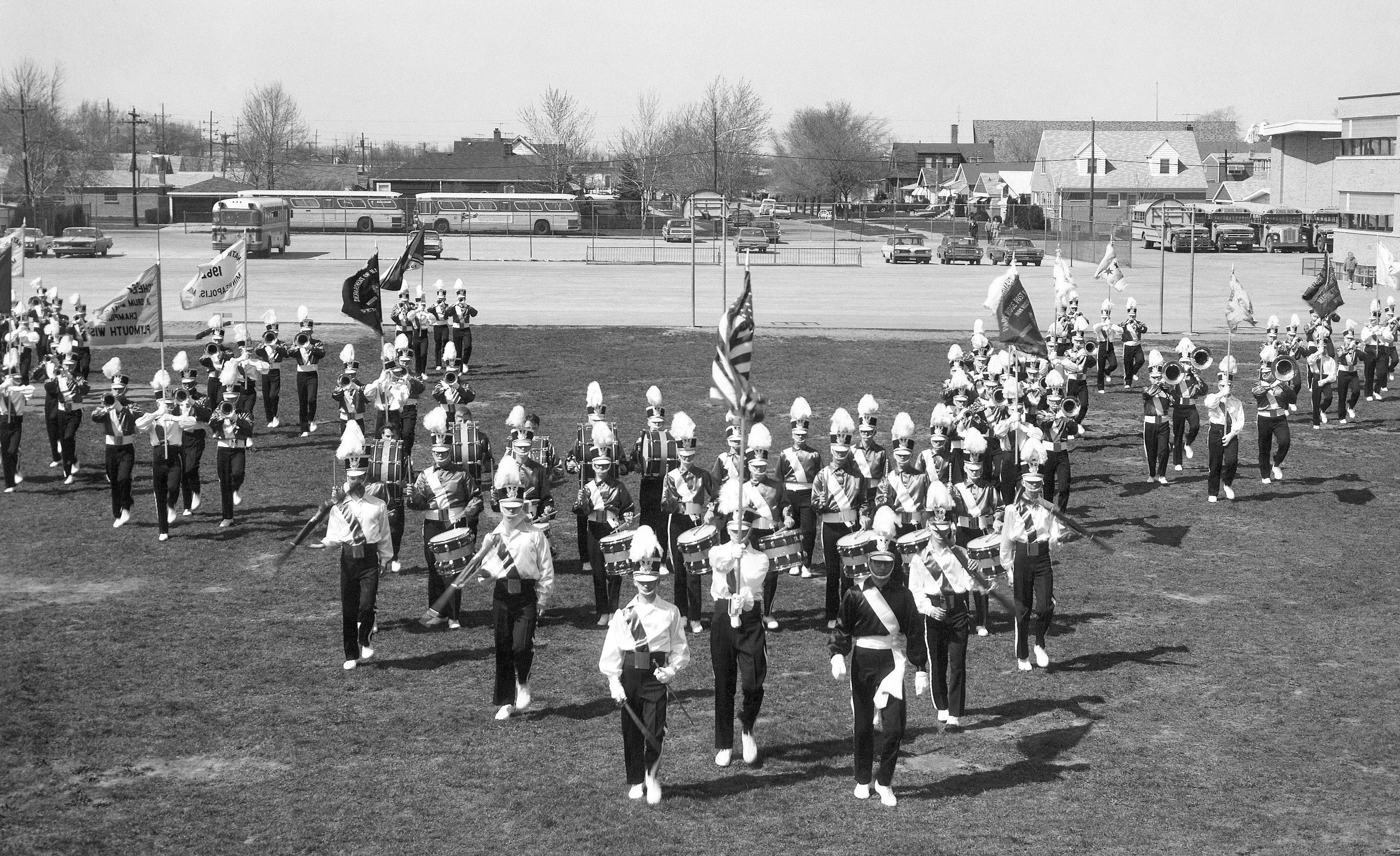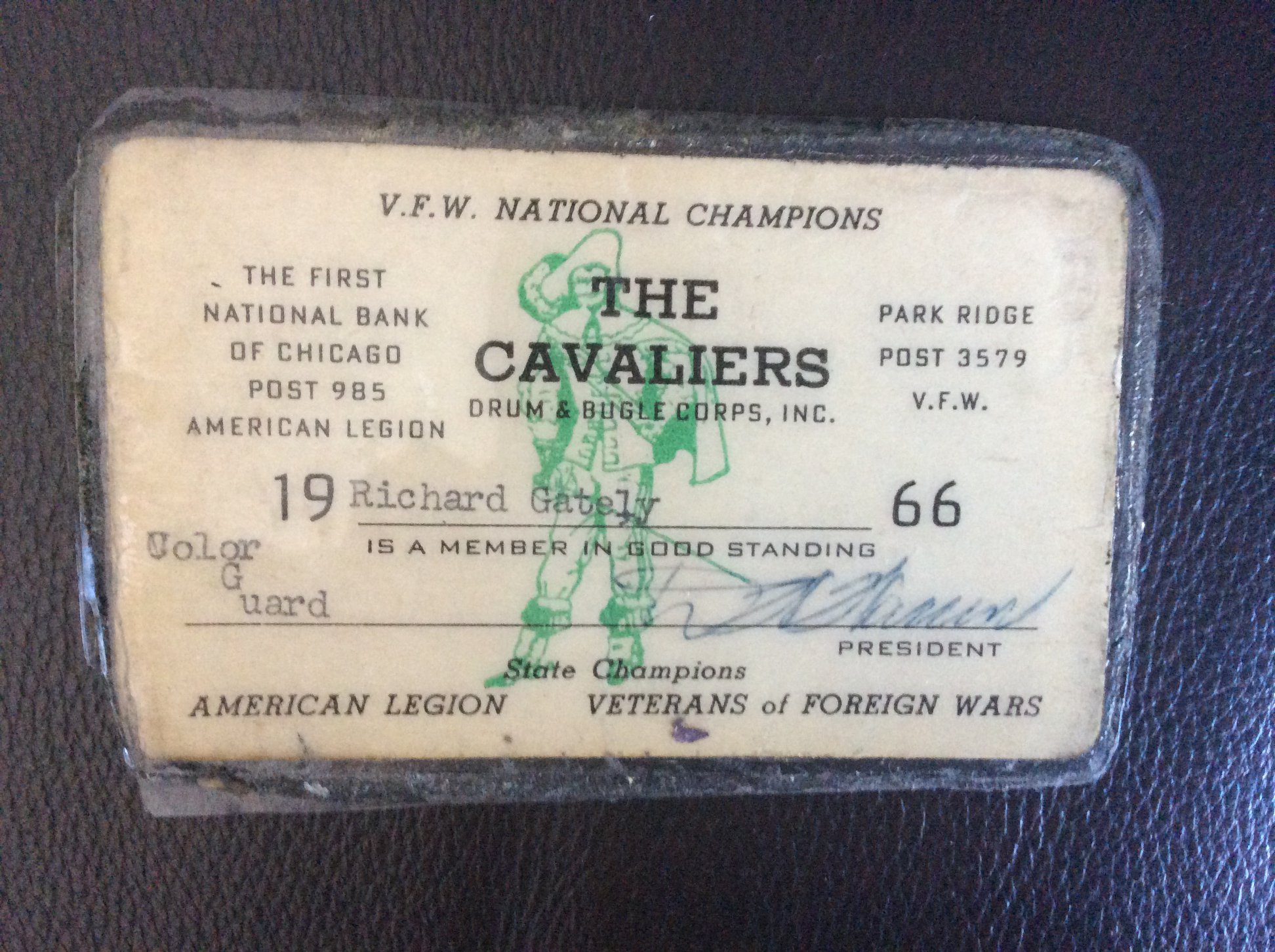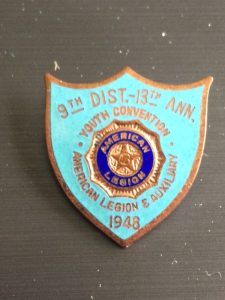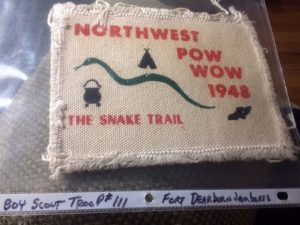CLICK HERE to submit content for this year.
General Season Overview Editorial Place Holder
STAFF MEMBERS
Administration
Design
Color Guard
Brass
Percussion
Visual
Electronics
Medical
Media
Cavalier Alumni Association Board of Directors
CAST
- Drum Majors and Officers
- Color Guard
- Trumpets
- Mellophones
- Baritones
- Contra / Tubas
- Front Ensemble
- Snare Drums
- Tenors
- Bass Drums
Drum Majors:
Alan Brinker
Guard Sergeants:
Horn Sergeants:
Drum Sergeants:
Color Guard
Trumpets
Mellophones
Baritones
Contra/Tuba
Front Ensemble
Snare Line
Tenors
Bass and Cymbals
Cavalier of the Year :
COMING SOON
Rookie of the Year :
COMING SOON
Music Selections
Bully – Mike Simpson
Battle Hymn of the Republic – Traditional collected by William Steffe | adapted by Julia Ward Howe
Land of a Thousand Dances – Chris Kenner
It Ain’t Necessarily So (from Porgy and Bess) – George Gershwin | Ira Gershwin
Tiger Rag – Eddie Edwards | Nick LaRocca | Tony Sbarbaro | Henry Ragas | Larry Shields
Somewhere (from West Side Story) – Leonard Bernstein
Documents
The Cavalier Championships 1966 – 1967: Two Years that Defined an Era and Created a Legend
The Cavalier Championships 1966 – 1967:
Two Years that Defined an Era and Created a Legend
Tom and I had decided to write this brief ‘history’ of the 1966 and 1967 Cavalier corps for Monk due to his failing health. We believe it gave him comfort to relive some of the memories and history he helped create and to help him remember all of us – his kids.
After Dad left the corps in 1972, truthfully, there was not a day that went by where he did not think about all of us and the accomplishments of the Corps called the Cavaliers.
Dad passed away on February 5th, 2002.
He is loved and he is missed! May God rest his soul.
1
After long thought on the subject, we have decided to set down on paper our recollection of the events and happenings during the 1966 – 1967 seasons that helped shape the lives of our family, many other Cavaliers and of course the Corps itself. I am receiving assistance in this task from my brother, Tom and my Dad, who you know as ‘Monk’.
2
Before I start this story, we would like to set the record straight as to how to regard our words. We have told and retold these stories to each other and other Cavaliers for almost 30 years. Although those of you who were not there will have a hard time believing this; none of the events we are going to set forth have been embellished, magnified or otherwise made larger than they were. This has not been necessary because the record of what the 1966 and 1967 Cavalier Corps’ achieved speaks for itself.
3
1966 Season
Finished in second place at VFW Nationals in Jersey City, New Jersey to the Troopers by .80 due to 1.00 flag penalty. 1) Troopers – 90.45, 2) Cavaliers – 89.65, 3) Boston Crusaders – 88.55.
Finished in First place at American Legion Nationals in Washington DC. Boston Crusaders second by 2.167. 1) Cavaliers – 85.23, 2) Boston Crusaders – 83.05, 3) Blessed Sacrament Golden Knights – 82.25, 4) Troopers – 80.50.
Won 21 shows, 13 in a row. Lost 3: Rockford to the Troopers (8th show of the year), the Dream to Blessed Sacrament Golden Knights and VFW Nationals to the Troopers.
4
1966 Show: 39 solos, 9 different soloists
Solos: Bully – 5 Soprano, 1 Soprano duet, 1 Baritone trio
Battle Hymn – 1 Soprano duet
Land of a Thousand Dances – 1 Soprano, 1 Mellophone
It Ain’t Necessarily So – 6 Soprano, 2 Baritone, 1 Mellophone, 1 French Horn
Tiger Rag – 9 Soprano, 2 Baritone, 4 Baritone Trio, 3 Mellophone
Somewhere (from West Side Story) – 1 Soprano
A word about the solos in the 1966 and 1967 season. Many of them were what we would call ‘major’ solos; in other words, long, a great degree of difficulty and requiring technical excellence, and ‘highlighted’ in either the drill, the music or both. There are other ‘solos’ from these years that were more the type of part where the regular parts were ‘doubled’ in range. We have counted these since they were still difficult and very exposed. There were also, what we called, obbligato solos (or obli-garbage depending on who you were talking to). Many of these parts were never written down yet played at every show. The Baritone trio’s were not part of these since they were passed by the instructors and formally approved. In any case, the Cavaliers in these two years probably had the greatest number of ‘legitimate’ solos by the largest number of different soloists ever put on the field even to this day. It was really a tribute to the depth of talent we had in the hornline and the willingness to not ‘play-it-safe’ and instead lay it all out there for the people and the competition to see and hear. To put this in perspective, Boston in 1967 had 4 Soprano, 1 Soprano duet and 2 Baritone solos in their whole show. By contrast, we had that many in Bully alone and the same was pretty much true of all the other corps at the time!
5
Horn Line 18 Sopranos (firsts-9, seconds-6, thirds-3)
6 French Horns
3 Mellophones
12 Baritones
3 Contra Bass
Total 42 (largest horn line marched in 1966)
6
Drum Line 4 Snares (largest number marched in 1966)
4 Tenors (largest number marched in 1966)
5 Bass Drum (largest number marched in 1966), including 2 rudimental Bass
3 Cymbals (largest number marched in 1966)
Total 16 Drums
7
Guard 16 Flags
6 rifles (12 pound Springfield’s – these were real rifles that were plugged and could not fire, but real in every other respect).
1 American Flag
1 Saber
Total 24 Color Guard
1 Color Guard Sergeant
1 Drum Major
Total 84 members
8
1967 Season
Finished in First place at VFW Nationals in New Orleans. The Troopers were second by .45.
Finished in First place at American Legion Nationals in Boston. Boston Crusaders second by .433.
Won 19 shows, Lost 6: Toronto to Boston, Delevan, WI. (3rd), Momence (tied for 3rd), CYO Nationals (2nd after Nationals), Toronto (2nd), and Rockford (2nd).
9
1967 Show: 33 solos, 9 different soloists
Solos: Bully – 5 Soprano, 1 Soprano duet, 1 Baritone trio
One Hand / One Heart-Les Preludes – 3 Soprano duets, 1 Baritone, 1 Mellophone
Concert Intro – 3 Soprano
It Ain’t Necessarily So – 6 Soprano, 2 Baritone, 1 Mellophone, 1 French Horn
Tiger Rag – 3 Soprano, 2 Baritone, 2 Baritone Trio
Somewhere (from West Side Story) 1 Soprano
10
Horn Line 18 Sopranos (firsts-9, seconds-6, thirds-3)
6 French Horns
3 Mellophones
12 Baritones
3 Contra Bass
Total 42
11
Drum Line 4 Snares (largest number marched in 1966)
4 Tenors (largest number marched in 1966)
5 Bass Drum (largest number marched in 1966), including 2 rudimental Bass
3 Cymbals (largest number marched in 1966)
Total 16 Drums
12
Guard 16 Flags
6 rifles (12 pound Springfield’s – these were real rifles that were plugged and could not fire, but real in every other respect).
1 American Flag
1 Saber
Total 24 Color Guard
1 Color Guard Sergeant
1 Drum Major
Total 84 members
13
The following events are as the three of us remember them (with some help from others as noted throughout the rest of this story), and are based on occurrences Tom and I and our other Cavalier brothers observed and what we later learned from Dad. Usually, after the shows were over and during the following week, the details of the different events and happenings would emerge and we would hear the ‘management perspective’ of what we had experienced. This side of things was a little more detailed and filled in some information that we marching members lacked. (For those of you unfamiliar with this story, ‘Monk” was Richard C. Wawrzyniak, and had joined the corps early in 1961, our first undefeated season. He was on the Board of Directors, was Equipment Manager and was the other drill instructor along with Lenny Piekarski. Have no doubt, he was one busy man but loved every minute of it). Others may have different recollections based on seeing or hearing something from a different angle or location. If anyone has been left out of this narrative it is inadvertent and we sincerely apologize for the oversight. Finally, although this story is told through our eyes, it is not meant to be the ‘Wawrzyniak’ story since we whole-heartedly believe that any one of the 1966 or 1967 Cavaliers could be substituted for ourselves and the outcome would have been the same – two seasons to remember for all time.
14
This is a long story, covering almost 2 ½ years. It has everything: great victories, painful losses, suspense, intrigue, humor, suffering, injustice and come-from-behind-when-all-the-odds-were-against-us wins. Above all, we think this story typifies the intense will to win that pervaded the Corps at that time. It says what it meant to be a Cavalier then and what it means today. This is a story for true fans of Drum Corps whether they wore Green, Black and White, or some other color scheme, whether they are a fan of ‘military’ drills or a believer in free-form constructs because we think this narrative identifies the essence of what the Cavaliers and Drum Corps are all about.
15
Our story actually starts at the close of the 1965 season at VFW Nationals in Chicago. Finals that year were supposed to be at Soldier Field, but were moved indoors to McCormick Place because the field was flooded in a torrential downpour just hours before the show. (This is before McCormick Place burned to the ground in January1967). Our chief competitor was the Royal Airs, also from Chicago, and believe me they were very good. What a horn line! The sad part of this is we had been beating them by points all year long up until the American Legion State competition in late July. From there on they won consistently and VFW Finals was not any different. We finished second that year. Our feeling was that we had let down and allowed the ‘Royals’ to sneak by. I’m sure they would feel otherwise.
16
Looking even further back, management viewed this as progress since the corps finished 3rd (for the first time) in Cleveland in 1964 and 2nd place in 1965 was a step up! However, management let it be known that they viewed 1966 as a rebuilding year since many of our most experienced members had aged out in ’65. This is where the real story starts.
17
Then, as it is now, it was very hard to ‘make’ the corps since we usually retained around 90% of the people from the year before. Just about the only way to make the line was for someone to leave or if the horn line was expanding the next year. In 1966, both types of change were occurring so there was opportunity for many new members to make the corps.
18
Since Monk knew the corps was going to be expanding in 1966, he had been looking for ways to find or create enough space to carry all the extra equipment. In the early 60’s the uniform racks were made out of very heavy pipe that screwed together to form space that the uniforms could be hung from. When traveling, the top of these racks were taken and strung across the bus aisle and the uniforms were hung from them. The shakoes were carried in long, thin wooden boxes, painted green, with six shakoes to a box. The horns, drums and guard equipment were all stored underneath the bus in the bus bays along with the guy’s personal gear. Well, as the corps got bigger, by 1964, dad would rent a small Ford Econoline van to put the uniforms into, again on the racks, with as many of the shakoe boxes as possible underneath the uniforms. Because the van was filled to the brim with equipment, only two equipment people could safely ride in it at any one time. Also, because of the arrangement of the racks and uniforms, it was possible for the uniforms to start swinging back and forth. This sometimes made the van unstable and hard to drive. Without a doubt, something different was needed.
19
Dad had his own business in which he sold and serviced fire extinguishers and sprinkler systems. One of his accounts was Mary Anne Bakery in Chicago. One day late in 1965, he was walking through their yard and saw a truck sitting off to the side. This was one of their all-aluminum, delivery trucks that had double doors in the back and which you could stand upright in. Dad asked why this truck was sitting there and one of the Mary Anne managers told him they were going to sell it. I don’t remember the reason, but dad looked at it and it was in very good shape. The body was fine and the engine didn’t have that many miles on it, so dad bought it on the spot. He didn’t tell Don Warren until the next rehearsal, when he showed Don the corps’ new ‘equipment’ truck. What could Don say except OK?
20
Next the inside had to be gutted and reconfigured to accommodate the special needs of a drum corps. Dad had been thinking for years about how to set up an equipment truck for a drum corps and this was going to be it (Later, in 1970, dad finally got the truck he really wanted – a full semi 18 wheeler and set it up the way an equipment truck should be set up). There were going to be ‘pigeon’ holes for the shakoes, numbered by ‘threes’ and with the uniform racks directly underneath. This truck had a pretty hefty air-conditioning unit for the passengers and its own independent power unit for those times when we could not get or have access to power at the show site.
21
Since we did not have a garage large enough to both house the truck and work on it too, dad would store the truck at a local gas station at night on their lot and then pick it up in the afternoon to work on it. We would take the truck to an alley behind Mr. Kosowski’s home where we parked in back of his garage. Mr. Kosowski was an accomplished carpenter and together with dad, Mr. Napolitano, Mr. Keller, Mr. Roussell and others who dropped by from time to time, we would work on the truck during the week. It was pretty cold that winter in Chicago, so work proceeded slowly until Spring arrived. Then the wood paneling for the inside walls went on followed by the cabinets for the pigeon holes and the uniform racks underneath. The cab was also paneled for the driver and passenger. The floor was covered by linoleum that was easy to keep clean since this was going to be a very high traffic area. Finally, all the interior furnishings were done. Now it was time for the outside.
22
The truck was not painted on the outside at all, just the bare aluminum and we definitely wanted to have it say our name. Dad had a friend he knew as a boy from the ‘old’ neighborhood who was a sign painter. (he also drank a lot so we watched him pretty closely). Dad gave him a few ideas and left the truck at his studio for two weeks. One day he called us to say it was done. I can tell all of you we were pretty excited so see what it looked like. Well, the color scheme was OK, and the Cavaliers in the ‘old-English’ script was OK, but it was still missing something. It was then that dad decided to have the bust of the ‘standing man’ logo painted onto the truck. It was on each side and also on the back doors. Dad also had the years of our Championships painted on the truck along with the sponsoring veterans posts and the 1st National Bank of Chicago who was also a sponsor that year. Over the cab was painted in script “The Cavaliers Are Coming”!
23
With these changes, the truck was perfect! It looked like the equipment truck you would expect a national champion to have. When we pulled up to the hall the first time in the truck when it was finally done in early May, there was a stampede by all the guys coming down to see what this was. It was beautiful and you could feel morale skyrocketing!
24
To our knowledge, this was the first ‘real’ drum corps equipment truck that was ever used in a drum corps anywhere. There were other trucks, but they were more general purpose and not laid out the right way for a drum corps to use. Also, we think most of these trucks were rented and not ‘owned’ by the corps, while ours was owned by the corps. This was the precursor for all others to follow. Later on at shows, the truck doubled as an office, tailor’s shop, emergency medical station and corps ‘staff’ car if something needed to be gotten in town. Everyone was in awe and very envious of the corps. Dad and the other equipment staff (Denny McCurdy, Louie Miller, Lou Fibel, Jim Zientara and later Frank Mostowski) ate it up! This was so well put together that kids and parents and managers from the other corps would come up to the truck looking for help / guidance on a number of areas from details about the show / facilities to where to go to eat to medical questions to needing help with sewing on last minute buttons, etc. Dad had a full emergency medical kit including oxygen (courtesy of Mom who was a nurse) and used it many times when kids from other corps would go down after a parade or a show. There was also a cooler with water and cases of coca-cola or other soda that we would sometimes get after a practice. It was great, especially when the truck followed us in parades and we could get water when needed. That was a BIG plus over previous years when water was supplied by a water-bucket on wheels someone pulled along behind the corps. It wasn’t a very good arrangement and the truck worked out much better all around.
25
At shows, each guy would come to the back of the truck and call out his number and the equipment staff inside would give him his uniform and shakoe. We experimented with the best method of getting the uniforms on and off the truck in the shortest amount of time. Sometimes, after a show when we were not so pressed for time, the individual members would come onto the truck, uniform in hand, and hang it on the appropriate, numbered hook and place his shakoe in the right pigeon hole. This took all of about 30 seconds and the guy was then on his way. The system worked well, but dad was still not totally happy with it because he wanted a truck where the members could enter from one end, collect or deposit their equipment and exit from the other end. This system would have to wait until the corps got their 18 wheeler in 1970. As far as equipment trucks go, dad was a visionary in terms of how to structure things for flow and ease of use. We believe the truck the corps uses today and all other drum corps equipment trucks are patterned after these first attempts.
Back to the story:
26
At this point some housekeeping is in order. We should give readers a sense of what the corps was like when it was not rehearsing or performing. The mid-60’s was a time of tremendous change in our society with the rise of the sexual revolution, civil rights, and the creation of alternative viewpoints on just about any subject. This included fashion and the corps was no exception to the changes in dress. There were several different ‘schools’ of dress existing at any one point in time. There were Surfer’s (no explanation necessary), there were ‘Mod’s’ (a less extreme form of hippie, but still clean and with Cavalier haircuts), there were ‘Duper’s’ (a style of dress somewhere between Surfer and Mod), there were ‘Greasers’ (no explanation necessary), and a few others that I can’t remember today. When together, the corps mostly wore Corps jackets and Corps t-shirts. This was really before the time when it was fashionable to wear the T-shits of other groups. This was also before the time when the T-shirt was viewed as an acceptable piece of clothing in its own right. No one was using dress as a political statement yet or as a means of protest. It was a matter of pride and esprit de corps for everyone to be dressed in Corps T-shirts and Corps jackets.
27
Perhaps the most fun we had, besides traveling on the buses to shows, was had at roll-call. Bob Hoehn or Jim Jones or Bruce Tietgen usually called the roll at the start of each meeting or corps gathering. The usual means of answering when your name was called was a loud ‘Yo’. To get a sense of this, see any John Wayne cavalry movie or any of the ‘B’-grade WWII movies from the 40’s and 50’s. In fact, the way the corps ran closely resembled some of the scenes from those movies. In the drill, we were organized in squads of 3’s, we had a command structure, we were always loading and unloading to travel somewhere, we had uniforms, we had tough competition and practices, we had ‘old’-guys and ‘new’-guys and many other similarities between ourselves and the military units depicted in those movies. Also, since we all watched those movies over and over, it was somewhat natural to adopt some of the more humorous aspects of these movies. The result was, at times, hilarious!
28
We can remember that when Dad called the roll, as he sometimes did, he would take some liberty with the pronunciation of some of the names of the guys. One sequence of question and responses was always guaranteed to have us all rolling on the floor.
Monk: Respondent: Monk: Respondent:
Brinker? Here!
Czapiga? Here! Nice job on the solo Thanks Monk
Heeres? Yo! Your aluminum bat is too loud I’ll take care of it
Karge? Yo!
Leone? Yo! We need help with loading the
Drums on the truck Sunday OK, I’ll be there! Martucci? Yo!
Metro? Yo! Also nice job on the solo
Rinella? Yo! Get a haircut! OK, next time.
Ross? Present! You just volunteered for the
The paper drive Sunday Aw, Monk, OK
Wells? Here! Get a haircut! Yeah, sure!
Hogland? Monk, it’s Hougland! That’s what I said, Hogland! No, it’s HOUGland!
29
This went on for a couple of responses back and forth and we were laughing so hard we were close to tears as this went on. Monk knew full well how Lee’s (Hougland) name was pronounced. It was just his way of helping to keep everybody loose and on their toes. It was great fun!
30
More to the point, since most, if not all, of our instructors and management were WWII or Korean War veterans, individual and group discipline was the watchword of the day. There was no, ‘I don’t feel like it today’ in this drum corps. Perhaps that is why we identified with the old movies so much – it reminded us of us!
31
In those days we rehearsed music every Wednesday night from 7:00PM –10:00PM at Cavalier Hall that was above Ferrara’s Lounge and an all-night Laundromat (this is important for later in the story). The Laundromat was in between Ferrara’s and Eddie’s Pizza which was on the corner. The entrance to Cavalier Hall was just a single doorway located between the Laundromat on one side and Ferrara’s on the other with a sign overhead giving our name. In January we also started drill rehearsals on Sundays for 3 hours at the North Avenue Armory. This continued until early April when we started rehearsing on Wednesday nights for music and Thursday nights for Drill for 3 hours each night at Hansen Park stadium. There were no lights at Hansen Park at the time so we would often rehearse until 9:00 or 9:15PM, the last 30 minutes in the dark, and then travel back to the Hall for our meeting.
32
My brother and I, along with several others, had been part of the Cavaliers ‘B’ corps since the winter of 1961. We ‘officially’ became alternates in 1964 with real uniforms and uniform numbers We had both marched 6 shows in 1965 as alternates for older guys that had school / work / military conflicts and who had to miss a show here and there. (This was the start of the Viet Nam war and it did affect the Drum Corps movement in the mid-to-late 60’s and early 70’s). At the first rehearsal for the new season in mid-September we learned that we had made the line and were going to march that year. It seemed like we had been trying to get here forever and now we had finally made it along with 12 – 15 other guys that were about the same age. ( in 1961 I was 10 years old and Tom was 9. We would not have made the corps in any event until we were older anyway, but try explaining that to someone who wants something very badly and won’t take no for an answer. Also, since Dad was already part of the corps, we went to many of the rehearsals, more it seemed, than some of the older marching members, and sat at just about every management meeting at the Terminal restaurant across the street from the Hall until all hours of the night.)
33
The second Soprano line shaped up to be very talented in ’66 and proved it at one Wednesday night rehearsal. Sal Ferrara was our music arranger and horn instructor. At this rehearsal he asked one of the ‘seconds’ to play his part from ‘Bully’, our opener that year. Not only was the part played flawlessly, but with power and with all the right phrasings and expressions. Then, the entire second soprano line (6 of us that year) played the same part even better as a group. As this was going on, I looked over at the ‘first’ sopranos ( 9 of them that year) and noticed a look of disbelief on their faces. This was not going to be a year in which the ‘old-guys’ could coast and rest on their laurels. The ‘new-guys’ (meaning us) were going to push them for all they were worth. We were going to make up for ’65 and have our title that year with them or without them!
34
One thing that I have always found in life is that, if you don’t like a situation or if certain people are a pain in the rear, the best way to correct the above is through the example you set. Push them till it hurts and things will finally be corrected. While all this was going on, the baritone line was also watching and after we finished they looked over at the ‘firsts’ and just smiled. The race was on!
35
As we both recall, rehearsals ran that way until early February when we had the first of 4 all-Sunday practices: the first half at the Hall and the last half at the Armory broken in the middle by pizza at the Hall brought up from Eddies. While setting up the tables and waiting for the pizza, we started singing. Right before the food arrived we sang ‘Battle Hymn’. We played this as our flag presentation (second number after Bully) that year and for that reason it had special significance to us. There were also quite a few other non-corps people in the hall that day that had come to watch the rehearsal. Well, when we started singing, you could have heard a pin drop! Not only was it good, it was beautiful. Unconsciously, we had started imitating the very same phrasings and expressions in our singing as we had been working on in our music. The effect was electric. People knew they were watching something special be born!
36
About one month later there was an early parade in downtown Chicago (yes, that’s right in March!!), which actually had a reviewing stand. Someone in the corps had a portable tape recorder and recorded us as we went by (at that time, portable meant small enough to carry under one arm. You still needed to plug it into a wall socket for power!), and we played ‘Battle Hymn’. We could hear ourselves as we got closer to the recorder and we sounded pretty good for playing in 35-degree weather. The interesting thing was the people: there was a hush falling over the crowd as we got louder and then they started cheering! This was not the normal polite applause you usually find at parades. People actually were enthused by what they were hearing. Needless to say we were very encouraged by this and redoubled our efforts.
37
By now, May was upon us and we were off to camp over Mother’s Day weekend. This took place at Camp Augustana, a Bible camp in Lake Geneva, WI. We had been out of the Armory for about 5 weeks by this time and had re-acclimated to playing outside. The horn line was powerful, even for May and we were pushing for all we were worth. The drum line in ’66 was extremely talented and very clean. We had no doubts they would win their caption at nationals. We had finished the drill before we were out of the Amory and things were really starting to click. The rehearsals at that Mother’s Day camp were very intense (for mid-May) and the people who were watching again got the feeling they were watching something special. We loved to perform our show that year! Not only was the program very good and interesting, it was fun to do. Give us a crowd, and we would turn it on for them!
38
One thing that my brother and I agree on that helped many of the guys in the corps was the fact that most of the houses in Chicago had basements. We would go downstairs when the snow was 3 feet deep and practice marching as much of the drill as we had up to that point while playing the show. Of course we could not do the entire drill as it was written since the space was much too small, but we worked on getting the timing down for starts, stops, pivots, wheels, dress-points, leg lift, etc. Anytime we made a mistake, either marching or playing, we stopped and started from the beginning. This was helping to build up our endurance and lowered our tolerance for errors. As you will read farther on, these traits became very important to the corps in ’66 and ’67. I remember the first time at camp when we did the closing company front in Somewhere. It was comprised of the entire horn line, except Contras, and started on the 50yard line and finished in the end zone (over the finish line). The front formed up, stepped off and exited the field – straight as a board. Dad and Lenny looked at each other and called for lunch. There was nothing else to do at that point.
39
We won the first show over the Royal Aires by points and kept winning by large margins over all the local midwestern competition every time we met them. A pattern emerged in which at these shows we would warm up the horns, work on some music and then go through the show only about 1½ times. Sometimes we would do the first half of the show up to concert, stop and return to the starting line. We would then do the entire show with concert and that was our rehearsal (sometimes we would reverse the order to build up endurance). The rest of the time was spent getting ready for the parade (there always was one) and having free time! This was because we were already in mid-season form and there was no sense in beating ourselves to death. We knew whom the real competition was and that was going to be the Troopers from Casper, WY. Our first show against them was in Dubuque, IA.
40
Dubuque was notable for three reasons. 1) it was the first time we saw the Troopers in ’66. 2) it had a God-awful long parade up steep hills and 3) because of the riot. (in this case the names have been changed to protect the guilty).
41
We were staying in the Loris College dorms and using their football field for practice. When we arrived in East Dubuque (the first part of Dubuque you hit after the interstate and bridge), we called the college and found out our rooms were not yet ready. The only thing to do was let the corps off and get something to eat, or in other words, free time! On the way to Dubuque we stopped at one of the large roadside restaurant / rest stops. This establishment had a large gift shop in which they had several hundred items displayed among which were toy starter’s-pistols complete with ammunition. After we cleaned them out of inventory on this wonderful item, we continued on to Dubuque.
42
The only place in Dubuque open at that time of night was East Dubuque, which as known as a ‘rough’ area. Don Warren told us to stay close to the buses and be sure we were ready to go when necessary. Well, as you might imagine, with the several very enterprising individuals in the corps that year, someone decided that a little fun was in order and, finding a bicycle that had lost its owner, proceeded to ride up and down the street. This does not sound like much until another gentleman who also wanted the bicycle decided to shoot the rider with the toy starter pistol and claim his chance at bicycling fame.
43
At this point I need to tell you about 4 guys that joined the corps in the winter from the South side of Chicago: Harry Moore and Carl Rolark (1st Sops), Rich Prophet (French Horn) and Elijah Monday (Contra). Before going any further I have to say that I have never met any finer people in all my life. At the time they joined they were the first non-whites ever to be in the corps. This is not because we had any sort of policy against Blacks, it was just that at that time in Chicago, most Blacks lived on the South side and the corps was on the North side. It was a very long way to come if you didn’t have a car. In all honesty, I suppose some of this had to do with the idea that the Cavaliers were too hard to get into and Black people just didn’t come to rehearsal that much. Anyway, these 4 guys were very good and wanted to be in the Corps in the worst way. They reminded my brother and I of how we felt when we were trying to make the line.
Back to the story in Dubuque.
44
At this point, we have a group of young men all wearing the same clothes (Corps jackets), walking around a rough neighborhood at 1:00AM with nothing much to do. Get the picture? One thing led to another and we decided to have a war between one group and another. I’ll let you fill in who was on what side. I vividly remember two scenes. One in which Harry Moore was running across the street with traffic stopped at a red light with a little old lady behind the wheel of her car. Getting in front of the car, he turned around and fired one shot at his pursuers who then proceeded to pepper him with a fullisade of answering rounds. Harry then rolled across the hood of this poor lady’s car and fell to the ground. After a three count, the lady peeled rubber and ran the red light, never looking back. The other incident involved two people in a second floor apartment over a closed up shop, both looking out their window on the carnage below as one group fired 10 shots on another group and 30 guys went down. Boy, were we good shots! The fact that these observers were both not wearing any clothes only made the whole thing more bizarre. There were other parts of this that I could relate, but I mercifully let a veil be drawn over the rest of the events. About that time the buses sounded the recall and we all cheerfully went off to our new rooms with clean sheets and air-conditioning.
40
In the best spirit of the Cavaliers, any trash that we left was picked up, the bicycle was reunited with its front porch and nothing was broken, except for a few shattered nerves.
45
The next morning, one of the guys got up early and went for some coffee (there was no cook truck at the time. All meals were had in restaurants). He returned with the coffee and the morning newspaper whose headline screamed “Overnight Riot in East Dubuque”. Fortunately, no names were mentioned since it was pretty dark and there were very few witnesses. However, the body count according to the paper was quite high. Who says you can’t believe what you read in the papers?
46
Well, practice went quite well that day, and we got ready for the monster parade. We remember seeing the Troopers going by the corps before we stepped off. They were good with their hornline sounding powerful and their lines straight! When we finally stepped off I remember being on an end and close to the people who were lining the street. These were very narrow streets and you were very close to the people. The comments were great to hear such as, “what a hornline”, “look at how they move together”, or “look at the back-sticking in the snare-line”. This is what made parades so much fun (if a 3-mile parade up and down 30 degree inclines in 90 degree heat can be called fun?). We also regarded parades as if they were almost rehearsals. We were in uniform, in front of the public, playing most of our music and marching. Sounds like a rehearsal to me! Towards the end of the parade we came upon the Troopers who had stayed to see us go by. We made sure the lines were straight and the hornline and drumline were playing as well as possible.
47
If memory serves correctly, we were on last at this show and we were pumped because it was our first meeting with the Troopers that year. This made it an important show for both corps. We had been waiting all year for this one and were determined to put on the best performance possible.
48
We did beat the Troopers in this show and it was very tight. Cavaliers 1st with a 72.63 and the Troopers 2nd with a 72.53! We knew this rivalry was just starting and they would be tough down the stretch. The Troopers could really march up a storm, their horn line was decent, and their drum line was not really all that good. They made up for this by having a relatively simple book that they played extremely well. Some of the parts in their horn book were downright chilling to listen to. Haunting is the right word for it.
49
Dubuque was a funny show because there was a large contingent of farmers / ranchers around the immediate area and they identified more strongly with the Troopers than with us big-city kids. After the scores were announced, a little old lady, grandmotherly-type, came up to Don Warren and started beating him (although not too hard) with her umbrella for daring to defeat “those wonderful boys and girls all the way from Casper, WY.” Oh, well! you can’t please everybody. This was also the first time the autograph seekers descended on the corps in strength. We were starting to get famous.
50
The next show was in Dixon and the Troopers were not there. We saw the Troopers again at Rockford and we were back to head-to-head competition with our main competitor that year. This show was somewhat of a sad occasion also, since Tom Hartig, one of our rudimental bass drummers was going into the Armed Service after the show. We got onto the starting line and Al Brinker started the corps off. We all yelled out “this one’s for Tom”, and Tom came back with “Splooie”! It was a very memorable moment and we were all sad to see Tom leave us, but his country came first. Unfortunately, we did not put on a very good performance and the Troopers were better than the night before. The Troopers were 1st with a 71.117 and the Cavaliers were 2nd with a 69.443, and all thoughts of a second undefeated season were out the window. Oh, yes. While no one ever publicly mentioned this possibility, we did think about it from time to time and were trying to make it a reality. The only consolation was that even if we had won this show, we still would not have gotten that undefeated mark as you will soon hear.
51
At this point, after the loss to the Troopers, we started rolling again and won the next 13 shows in a row, all against local competition. However, it was quite easy to stay focused on who the real competition was and we meant to make up for that early loss. Practices were even more intense as we pushed ourselves and our instructors to make us even better. We kept to the 1 ½ times through the show format at contests since we did all our practicing at Hansen Park and not at the shows. However, I can still remember leaving to get something to eat after the parade and seeing the Royal Aires, or Skokie Vanguard or the Kilties, or any of our local competition practicing intently only to return hours later and they were still at it. The point is they were not getting any better, they were getting tired and getting worse all at the same time.
52
We remember one Sunday afternoon, about half-way through the season when there was no show scheduled and we were rehearsing at Hanson Park. It was very hot that day and rehearsal was long, but intense. The rehearsal finished and the corps loaded up ( for these rehearsals, each member either drove himself to the rehearsal site or got a ride) their respective cars and left. Since we lived about four blocks from Hanson Park we were really not in that much of a hurry and were the last one’s to leave. Dad started up the corps truck, the air-conditioning was just stating to make it presence felt and we slowly started moving when we saw someone running towards us, waving his arms frantically. We thought something was wrong / someone injured, etc., so Dad stopped the truck and Tom opened the door. This person ran up – out of breath and said in halting English: “ I need two Tuity-Fruity’s”! (I swear this is true!). He then looked up into the truck and got that ‘deer in the headlights look’ as he realized that something was a little out of place. (you have to understand that the corps truck was pretty hard to mistake as anything else but a corps truck – it was certainly NOT like an ice cream truck). Well Dad said something about this guy’s intelligence, Tom slammed the door and we shot out of there! There was silence for about 10 seconds when we all stated howling with laughter! There was never a dull moment!
53
The secret of winning is focus, focus, focus! Keep the goals clearly before you at all times This can be tricky since you can lose sight of the trees because of the forest! One of the little tricks we used to do was psychological in nature. We used to pretend that no matter where we were, and no matter how much we were going to win the show that evening by, the Troopers were watching us rehearse. And, no matter how good we were during the last time through the drill, if there would have been a show right at that second we would have lost to them by .10 to .20! Now that’s the way to keep on your toes when you know it will be weeks before you see your rival again. And do you know, it worked.
54
Our next meeting with the Troopers was to be in early August at Delevan, WI. This was always a Friday show and we had to leave in the mid-afternoon because of rush hour traffic and because we never knew what position we were going on – these were still the days where corps drew for position at the manager’s meeting the day of the show. It was also the days when most of the guys had real jobs they worked at during the summer, so they needed to take off from work early. We can remember a sense of anticipation and excitement as we watched each guy show up to the hall before the buses pulled out. We finally left and got to Delevan in time to do our normal 1 ½ times through the drill. Well we beat the Troopers that night. The Cavaliers were 1st with a 78.33, Troopers 2nd with a 76.12, Royal Airs 3rd with a 71.98 and Norwood Park Imperials were 4th with a 69.88, and this win proved out our way of doing things. We also met the Troopers at Momence the next day and won again. The Cavaliers were 1st with a 80.27, the Troopers were 2nd with a 77.92, the Royal Airs were 3rd with a 76.40 and the Skokie Vanguard were 4th with a 75.00.Not only were we winning, but the score was going up and the spreads were increasing. It looked like we were on the right track for a win at VFW that year!
55
Now it’s getting on towards mid-August and we are about to leave for the final tour and Nationals. While my brother and I, and a lot of other new-guys, had been to many local shows, we had never been to a real Nationals out East (we didn’t count Chicago VFW in ’65 since it was in our own city). The first show was going to be in Utica, New York and it was mostly all eastern corps, with the exception of Skokie.
56
When we got there, we unloaded and immediately went to the practice field that was behind the stadium. The show promoters had set up small, portable lights since they knew we would be getting in late and darkness would already be falling. There was a rather large hill between the field and the stadium. When we got to the field, there were almost 2,000 people sitting on this hill waiting to see the ‘mighty Cavaliers’ from the Midwest. You must remember this was in the days before the internet, CDs, video tape, MP3 players, cheap airline tickets, etc., and people had heard about our show through Drum Corps News, but that was all. No one from the East had really seen us except a very few judges. That they were very curious is a large understatement.
57
Well, all these people waiting to see and hear us got us pumped and we put on a pretty good show for them, but still not pulling out all the stops. We reserved this for the actual show itself and did our normal 1 ½ times through the show. People didn’t understand why we stopped and thought something was wrong. They thought we would practice for 1-2 hours and stop right before we went on, when instead we only practiced for about 35 minutes. Just enough to get the kinks out. As I said, I thought we did OK, but nothing special. The crowd thought otherwise and really started cheering, especially during the ‘Somewhere’ front. They really liked our show. And realistically, the show that year had just about everything you could ask for. It had Spanish, it had Patriotism, it had Jazz, it had Soul/Rock, it had Dixieland and it had a big show tune. On top of all that it had soloists and solos out the gazoo, duets and trios thrown in for good measure. It had a drum solo with tremendous back-sticking and precision marching that had to be seen to be believed! These people were in for a lesson on what the quintessential Drum Corps was and they knew it! We were on last, probably due to the fact that the show sponsors knew we were getting in late and they wanted to give us enough time to practice and get dressed for the show.
58
Well, when we actually got to the contest stadium, 2,000 people had become about 8,000 and they loved the show. We won the show and people booed because they thought the margin was too narrow! The Cavaliers were 1st with a 86.166, St. Joes of Batavia were 2nd with a 83.30, the Magnificent Yankees were 3rd with a 82.383 and the Vanguard were 4th with a 81.75. We left to stay in a real hotel in downtown Utica before leaving early the next morning for the Dream in New Jersey. This was a multi-story hotel with at least 12 stories. We slept 4 to a room. It was a hot night and there was no central air so we opened the windows and started to go to sleep, when we heard what sounded like a murmuring from far off in the distance. Getting up and looking out the window to the street below we see a fight going on in front of the hotel. No, this was more than a fight, it was a full blown riot going on for real this time! Since we had to get up early the next morning and also since we were on about the 9th floor we decided to end this little fracas as quickly as possible. You know, it’s amazing what a pillow case full of water feels like when it hits you from 9 stories up. After about 20 of these hitting almost at the same time (the word had spread fast to the other rooms and we liked to keep things coordinated). End of riot!!
59
One thing I will have to say to any drum corps who has dreams about being a national champion. It’s not just about how high you can push the score, or how clean your horn line is or how hard your drum book is or how good your show is. It’s all about looking adversity in the face, coping with it and persevering when all others about you are loosing their heads!
60
The next morning is when the trouble started. As we learned, this hotel had a very unreliable message system. Unreliable to the point where half the rooms did not get a wake up call the next morning – including Don Warren and most of management! Fortunately, an exception to this was Bob Hoehn. After Bob pounded on doors to get people up and onto the busses – with no breakfast I might add, we were on our way to the Dream and to see the Troopers for the first time since Momence. (for those of you wondering, this is in the days before we had a cooking crew or even traveled with food stored away. All meals were had in restaurants!).
61
Dad and the equipment staff had gone ahead in the corps truck to get set up and to draw for position. This was an afternoon show and started at 1:00PM. There was a junior corps show first and then a senior corps show after that. Since we were getting such a late start, we really had to push to get there in time to have a chance to go through the drill, etc.
This next part is one that Don Warren does not believe and denies to this day!
62
The Dream was run by Blessed Sacrament, who also were competing in this, their own show. This was a common practice at the time, and done mostly to save on needing to pay out additional prize money. When Dad got to the management meeting at around 10:30 AM, he found he was the last one there: all the other corps had already drawn for position (this was done – believe it or not – by picking a number out of a hat!). Normally, the draw did not take place until all those drawing were present, so this departure from the norm said something was up.
63
The person who was running the show (no names please) held the hat above eye level and Dad reached in to get our number. Well (and this is the part Don has trouble with – I don’t blame him either since we are talking about an adult here), as Dad did so he noticed a small finger movement and a very small vibration. He picked the number out and it was #1. We were going on first and had not even arrived in town yet. It seems that in order to assure themselves of placing well in their own show, Blessed Sac had rigged the deck and placed our number 1 positioning under the hatband so that when we finally arrived we would be sure to draw the first spot. Dad surprised them all by saying that this would be fine with us since the ‘kids’ never got a chance to see the other drum corps perform and would love a chance to sit back and relax a bit! This caused quite a stir since, those that knew of the ‘fix’ anticipated an argument about the way the drawing was done.
64
When we finally arrived, around 11:45AM, we got the word of our show time and position. We really had to hustle to get things unloaded and dressed with enough time left over to do the drill and get the kinks out. We still had not eaten since there was no time. Fortunately, our facilities were right underneath the stands and we did not have to travel to the show site. When the first Cavalier stepped out of the dressing room, as if by magic, a path cleared so we could get through the crowd quickly. People had heard what had happened (the drawing of first position) and they could see the look of determination on our faces. We were pissed to say the least!
65
What was so upsetting to many of us was the fact that this was our first rematch against the Troopers at a major ‘national’s-quality’ show. The Dream was also the last show right before nationals, with many of the judges that were going to be at nationals were in attendance even though they were not actually judging the show that afternoon. We needed to have the best possible performance to show everyone who was going to be the champion that year. On top of all this, since the Dream was so close to nationals, the crowd was huge ( I never did find our exactly how many were there but it must have been upwards of 25,000), and was the biggest drum corps crowd I had ever seen up to that point. Now things were definitely not going well with all this rushing about and going on first.
66
We walked about three blocks away to a supermarket parking lot and warmed up the horns. Sal got us calmed down and turned in the right direction. We were focused on one thing – the Troopers, and nothing was going to stop us from beating them that day! The interesting thing about this parking lot was that it was full of cars and people buying groceries since it was noontime. When we finished warming up, we decided to do one run through. Now you know why all those previous shows we had been to in ’66 and only went through the show 1 1/2 times was so important: it was preparing us for this. Well, we did the drill. If you can imagine marching around light poles, cars, grocery carts and people staring up in amazement at all these crazy guys in uniform who had appeared out of nowhere and taken over their lot, you have the picture. If there ever was a rehearsal before a major show that was more screwed up, I don’t know when or where it was.
67
Since we were quickly running out of time, one shot was all we got. We then hustled back to the stadium and lined up. There was no talking, no fooling around and no nervousness either. We were pumped and focused!
68
The show that year started with the horn line on the starting line in a double front, one 8 steps behind the other. The drum line and guard also were in double fronts with the drum line towards the middle of the field, the horns towards the front side line and the guard towards the back side line. What we usually did was have Danny Heeres, a first Baritone, march out alone and count off the right number of steps for the first spot on the line. Everyone else followed after that. In this case, since we were on first, Danny trooped the entire starting line from side to side before he set up and then snapped to parade rest (some of you may have seen a picture of Danny in uniform, at parade rest. I think it is in the archives somewhere and he looked just like that at the Dream). The crowd started to get quiet. It’s amazing how quiet 25.000 people can get. Danny then stood there for a couple of minutes before our drumbeat ( what is now known as IOWA, IOWA) started and the rest of us came out swinging the horns. Now the crowd started standing and cheering and we hadn’t even played a note yet. It was the same story as in Utica. People had been hearing all year long about how good we were and now they were seeing it. They started to get excited. Their excitement rubbed off on us because we could all sense how much we wanted to make this a special performance.
69
By the way, in case any of you are wondering why DCI abolished the practice of allowing a corps to play itself on the field, the above performance at the Dream and at many other shows before and after this date is the reason! We always felt that the show really started when the first Cavalier stepped out of the dressing room in uniform and continued all the way through the ending note of the show to trooping the stands on the way off the field! We were proving it now because the odds were against us and we needed all the help we could get at this point.
70
As everyone finally was on the field and marking time on the starting line, we were pulsing like a machine, all as one, and the dust started to come up. Al Brinker, our Drum Major that year, called us to a halt and we stood there motionless, waiting. It was as if we were saying, “OK, you tried your best to screw us up, but now it’s our turn. You aren’t going to know what hit you after we’re finished today”! At this point Dad and the rest of the equipment staff came out to the starting line with water and cold towels. This was a ritual for the corps on the starting line before every performance. If you have never been hit with an ice-cold towel right before a performance, you have really missed something! We can guarantee that no marching Cavalier was ever anything less than clearheaded after this treatment!
71
Since it was 1:00PM, it was really hot and bright out (no sunglasses in those days on the field). Just about then, most of us finally had a chance to look up in the stands to see what kind of a crowd there was. Usually, we didn’t pay much attention to the people in the stands until we were finished with the show. We were usually too focused on what was happening on the field to worry about what people were doing or not doing in the stands. But today was different. There were people, and people, and more people: so many people that I wondered to myself why the stands didn’t collapse?
72
Then the announcer came on and announced us. Brinker saluted and we came to attention. The crowd was on their feet again and we were READY!
73
As I said before, our opener that year was ‘Bully’. This song had everything in it a drum corps fan or judge ever wanted to hear. There were soprano solos and duets and a baritone trio. The baritone trio (affectionately known as the ‘Andrews Sisters’) is interesting.
The following is taken from a post by Wayne Karge, one of the ‘Andrew’s Sisters’ in 1966 and 1967.
74
The trio’s (also one in ‘Tiger Rag) played by the Andrew sisters were not written by the instructors. Danny Heeres, Wayne Karge and I (Wayne Karge) just made up the three-part harmony one night in a sectional, and played it when the corps got together at the end of the night. The staff liked it, so they wrote it into the show, pulling the guys out of the drill to highlight the trio. This was never planned, it just happened. As a matter of fact, as far as I know, the parts were never written down on paper.
It was an instant hit and everyone – corps members, the crowd and the judges – all loved it. In fact Tom and I recall Monk later telling the corps that one of the judges had written on the sheets that the corps (referring to the trio), did everything on the field except build a house. It was a fun piece to play and march.
75
We had 5 different soloists play in Bully in 1966. All the solos were pretty difficult at the time considering we were just playing on pieces of pipe welded together (not like the much better quality instruments corps’ have today). Randy Czapiga played the opening soprano solo off the starting line and the ‘call’ to the bulls solo. Then came the baritone trio with Heeres, Karge and Ross. The long soprano solo in the middle of the song was Randy again. At the end, the duet was played by John Leone and Randy. The opening bass drum solo was played by a snare drummer (Ron Herrmann) on two base drums held together and during the call to the bulls solo the snare line played an open stroke roll in unison for at least 15 seconds and it was very difficult to do.
76
If you have never had the privilege of listening to the record from the Dream ( sorry, no CDs or VHS tapes yet), you have really missed something. To me, our performance that day was really the start of Drum Corps in the ‘modern era’, not because of the complexity of the arrangements or of the drill. Not because of the cleanliness of the performance, although it was very clean for a non-nationals show. No, it’s because of the professionalism we exhibited that day under intense pressure and the emotion we engendered in ourselves and in the judges and in the people. WE WERE HOT ON THIS DAY! From the opening note of Bully to the last note of Somewhere, it was like it was one long cheer! The crowd never stopped!. It was one standing ovation after another. They cheered for the soprano solos in Bully. They cheered for the baritone trio in Bully. The cheered for the soprano duet at the end of Bully. The drumline got a standing ovation (which was unheard of in those days) for the back sticking in the drum solo before Battle Hymn. They really cheered for the end of Battle Hymn. In fact the ending note of Battle Hymn just hung in the air even after the note was ended. They loved the cymbal rides that started Land of a Thousand Dances. They loved concert and the long soprano solo Ron Metro had in the middle of the song. And they were blown away by the baritone trio in Tiger Rag and by the big ending in Tiger. When we hit the front in Somewhere, they never stopped again until we were completely off the field. What a show! I think it safe to say that we were all stunned by the amount of crowd response we received. After all, we were the guys from Chicago, on the East coast and at Blessed Sac’s home show! In those days, you didn’t necessarily expect people to be so ‘giving’ of their appreciation and admiration. I’ve always felt that the longer we could have stood there, the more people would have cheered us. They’d be still be cheering us today. There is a place on the record, just towards the very end where the crowd noise increases again. It’s when we took off our shakoes as we were standing on the finish line. They even applauded us for that! What a drum corps crowd!
77
Now for the bad news – we lost that show! Not to the Troopers, wonder of wonders, but to Blessed Sac! They were first, we were second and the Troopers were third. What a screw job! Since we were from the ‘hated’ Midwest, we thought the crowd would have appreciated Blessed Sac beating us. Boy, were we wrong. The crowd must have booed the results for a good 3-4 minutes and we thought we were going to be in the middle of another riot – just like in Utica the night before. The only consolation was when Blessed Sac came off the field, someone threw an ice cream cone out of the stands in disgust, which hit their drum Major in the chest and then slowly slid down to the ground. Oh well, maybe there is some justice in the world after all. However, it was of small consolation to us at the time.
78
We were more angry than disappointed at this turn of events and pretty much resolved not to let it get to us. This was not the Nationals slate of judges and people pretty much knew who had won the show anyway so we just got down to business. We were staying at a motel in Cherry Hill, N.J. and it was OK as far as the rooms went. You just had to disregard the notices in the lobby of what the hourly rates were. What are hourly rates for anyway??
79
For those of you, who don’t know, VFW was always regarded as the show where ‘precision’ was valued above anything else and the tolerance for any mistake, no matter how small, was wound down to the absolute minimum! We knew we were in for a fight from the Troopers and the spread promised to be exceedingly thin. American Legion Nationals was the show at which tolerances were relaxed somewhat in favor of more General Effect. VFW only had 10 points in GE, the rest being assigned to execution captions. VFW also had 10.00 points for inspection and 10.00 points for cadence. AL had 30 points in GE, with the rest spread out to the remaining execution captions. This is probably because AL had a ‘senior’ title along with the ‘junior’ title. The seniors could not be expected to perform at the same execution level as the juniors since the seniors were in some cases ‘old’ men and just were not up to it (We do remember one story of a guy who marched in Archer-Epler who was over seventy years old!).
80
Also, by way of explanation, shows in those days were judged = 11 ½ minutes and corps must exit the field by 12 1/2 minutes. There was usually a concert somewhere in the show played at a halt. Every corps entered from the starting line (stage left) and exited over the finish line (stage right). Most of the shows had a parade in those days: the VFW parade was the day before the show and the AL parade was the day after the show. In addition, each national title show had a judged inspection and a prelims. In the case of the prelims, of course the contest rules for the VFW and AL were different enough so that corps attending both shows needed to learn two different preliminary shows. As you might expect this put a lot of pressure on us especially with so much riding on the outcome. To be truthful, we really didn’t pay that much attention to the preliminary results. Up to this point in time we were either the defending champion or were in contention so we knew we would score well and go on late in the show. We did, however, pay GREAT attention to the inspection. Errors (Irish pennants, shoes not shined, haircuts not uniform, horns, drums and rifles not clean, etc) found by the judge (0.1 for each) were subtracted from our final score and there had been some titles lost by other corps in previous years because of this. Needless to say Dad was resolved that we would not lose even one tenth if he could help it (this becomes pretty important in ’67 at AL as you will hear).
81
The weather had turned hot and muggy, perfect for nationals and we rehearsed at an abandoned baseball stadium. The reason for this is that VFW was at Roosevelt Field, a baseball field, and we felt it would be better to practice on the same kind of field (by the way no lights at this practice site). Things were clicking along very well and drill practices were running very smooth. We corrected some problems that had bugged us all year and we felt we were ready. Bring on the Troopers!
82
To give a sense of the time frame involved here, the Dream (Roosevelt Stadium by the way) took place on August 21, 1966. VFW was on 8/24/66 and AL was on 8/28/66. Never before (at least up to that time) had so many big shows occurred in such a short time frame and in such a limited geographical area and with major competition at each show. Needles to say, drum corps fans were very excited and turned out in very large numbers everywhere we went.
83
The parade was noteworthy for three reasons: it was in New York City, which many of us had not been to before, it was at night and was judged (no effect on scores at finals- they always told us that, but sometimes it sure didn’t feel that way), and went down some side streets. We stood around for what seemed hours until it finally was time. You never saw so many guys move so fast for a parade. This was now our time and we were going to make the most of it! We started out and the lines were straight, files were covered and the drum line was hot. One thing we had tried to do all year was regard a parade as a drill practice (what else can you do at a parade). In this case it was a little different because some of these streets were very narrow, putting us right next to the curb on either side and very close to the people. This last point is important because during one of the delays in the parade, we stopped between a row of brownstone townhouses on either side of the street. New Yorkers never have been known to miss a good reason for a party and the VFW parade was no exception. These people were having one massive block party just as we were passing by. Never had so many of us gotten offers of a drink or something to eat at a parade in our lives, not to mention offers from several young ladies who couldn’t resist men in uniform. We had not broken ranks (but I’m sure we broke some hearts that night), remaining at parade rest until the word came to move out. Fortunately, the word came quickly otherwise the ending of this story might be very different. What a night!
84
The next day was prelims and it was hot! We stood inspection first and passed with flying colors! Dad was proud of us that day. We put on a pretty good show, but did not have things cranked up as high as we could have. The Troopers finished first with an 88.45, we were second with an 86.90. We were not really that concerned since prelims were not the deciding factor that they are today in DCI, plus neither we nor the Troopers were the defending champions from 1965. That was the Royal Airs and they would be on last anyway. However, any loss to the Troopers was not a good thing right before finals and we resolved to push even harder at rehearsals from then on!
85
That night, Dad informed us that we were all invited to a party, the ‘Big Boo’ Party. So instead of getting on the buses and going to get something to eat, we stayed at the motel and used their kitchen and had the spread in a conference room. We were all kind of mystified by this (even we didn’t know what was going on. Dad had kept it a secret the whole season). Back at the first show, Denny McCurdy one of the equipment crew, had set out a bucket on the back of the equipment truck and when one of us went to get his uniform we were informed, “Put something in the pot, boy!” well, over the course of the season, Dad had collected $300 – $400.00 (a lot of money in those days). So much money in fact that Don Warren was becoming concerned and kept asking what it was all for. Dad didn’t tell him, saying instead all would become clear at VFW.
86
Well, when we got there we were treated to quite a spread of cold cuts, roast beef, shrimp, salads and everything in between. It was great! The best part was to come because from then on, for the rest of the trip, during our breaks we always got Coke to drink along with water! Talk about the gift that keeps on giving!
87
The next day (8/24) was the day of finals and we were anxious to get to rehearsal and get down to it. We can tell you that these final rehearsals were probably the best practices we had ever seen!. Everything was flawless – horns, drums, guard and drill were clean, clean, clean. Dad later told us that he and Lenny were getting really worried because they couldn’t find any real errors. By the time they had gotten to a problem area, it was fixed. ( we should add that in those days, M&M judges would usually allow you 2-4 counts to recover an error before it went down on the sheet as a tic. By the time we were at this final rehearsal, guys were correcting mistakes in one count or less).
88
Up to this point in time, the most perfect show the corps, or anyone else for that matter, had put on was felt to be the Cavaliers’ performance in Miami, Fl. at VFW nationals in 1961. As far as we are concerned, our performance at VFW in ’66 now took over that position. We were incredible at this show. There are so many things we could say about it that this story would be 150 pages instead of 40! By way of example, our drum line was really excellent and expected to win drums every show. We later heard that the drum judges (there were two) only recorded two errors for the entire first half of the show through concert and were running around the field frantically looking for a mistake, any mistake! The drum score was 18.70 (average) out of 20.00. Five of those twenty points were for difficulty. We got a 4.70. So for the entire show we made only 10 errors!!!!!!!!!! And we had that incredible long roll in Bully plus the 120 count drum solo with 32nd note paradiddles, back sticking, and flip sticking. Bob Currie said it was the best drum show he had ever seen. We think it IS the finest show ever given the level of difficulty and the extremely high level of execution that evening! Now that’s drumming! There are similar stories about the horn line and drill. Suffice it to say, we delivered on performing at the absolute peak we were capable of that night.
The following is from the perspective of Denny Doud, who was our drum instructor that year along with Larry McCormick.
89
On Rodney Goodhardt’s sheet we had only SIX errors: only THREE on snares, just ONE on tenors, and TWO on basses. He gave us a 4.1 out of five in difficulty, which was a joke considering the book we had. His comment was “Pos. the best execution Performance I have ever-ever seen,” with performance and ever-ever underlined twice. His total was 18.60. On Bob Currie’s sheet we had NINE errors: only SIX on the snares, again just ONE for tenors, and TWO for basses. He gave us a 4.7 in difficulty which is accurate. Bob’s comment under execution was “the greatest,” with greatest twice underlined. His total was 18.80. So this show might be considered the greatest ever for a tenor line. Oh, Bob had two ticks on the snares in the opener for non-uniform beat with “smallest” written next to them. So I was incorrect about no ticks before concert. He snuck them in somehow!
90
To give everyone a sense of how good our performance at this show really was, after listening to the record, you can hear at least 17 ovations from the audience. I’m sure some of these were standing ovations, but I and everyone else was focused elsewhere so someone else besides the marching members from that year will have to define this part more fully.
91
However, as they say, “the best laid plans of mice and men oft-times go astray”! We lost the VFW national title to the Troopers by 0.8 in 1966 due to a 1.0-point flag penalty. Without the penalty, we won the show by 0.2! We are not going to comment on whether or not the penalty was really there (it was), or if some judges knew it was there and said nothing all year long (they did). Rather we are only going to say that we were very disappointed and angry that we had not been good enough to overcome even a 1.0-point penalty to win.
92
The American Flag was carried by Ed Atkabowski in 1966. Ed was very tall – maybe 6’4” and very strong. His standard practice was to troop the stands after the corps came off the field holding the flagpole at the very bottom straight out from his shoulder for the entire length of the stands as we passed in review. He never dropped it, nor did it waver (too much) from the vertical. Sometimes, if it were windy, he would use two hands at the bottom of the pole to steady it. It was a sight to see and everyone in the stands always made sure they saw the corps pass in review just to see this. As far as we know, no one in any other corps did anything like this. Ed was liked and respected by all and we all felt very bad for him after the details of the ‘penalty’ were known.
93
However, he did not make a mistake. The penalty was written into the drill and had never been found in previous performances. After this happened, CJSA, (Central States Judges Association), the judges association assigned a penalty judge to every show (in those days, not every show had a judge watching for penalties. Timing yes, but not necessarily for flag violations), the next season to ensure this wouldn’t happen again. In part, the judges association admitted some of the blame for not finding the error prior to nationals, but that didn’t change the results. They felt they had failed in doing their job by not finding the error during the season. To some degree they are correct. The corps had been to both Illinois State competitions (where there were prelims at each), and there were penalty judges in attendance. I believe that we also saw penalty judges at least one other time during the year before nationals so it makes you wonder what was going on. In the 6 – 7 shows leading up to VFW Nationals where we had penalty judges on the field, no one ever even mentioned the possibility of a flag violation. Also, if any of the M&M judges would have caught the violation, like Earl Joyce did, it would have been brought to the attention of the scorers at the tabulation table and the penalty would have been assessed.
94
Many of us know Earl Joyce, the judge who saw the penalty. He was in tears that night. He respected our organization and it killed him to have to give us the penalty. We always felt we were going to get the best possible reading of our show from him and respected anything he had to say. The last time I (Wayne Karge) saw him was just after the 50th anniversary party, and he was still apologizing for giving us the penalty.
95
Many things have been said about this over the years. Readers are probably wondering why this event has assumed such a large place in the history of the Cavaliers. We have won and lost plenty of other VFW, A.L. and now DCI national competitions. However, none of these other shows was ever lost due to a penalty. In fact, as far as we know, this is true for the entire junior drum corps activity as a whole. No other corps was ever in the same position we were placed in that night – and we would not wish these circumstances on anyone.
96
The ‘bottom line’ as they say is this. If our performance that evening had been any less amazing, if we had come off the field with anything less than a complete confidence in our performance and in ourselves, if we had immediately started watching the Troopers performance to count tics because we felt we were in trouble, or if we had stood in the finale keeping fingers crossed hoping we had gotten a gift from some judge or that hoping a judge had missed a grievous error in the show somewhere, then we would have ‘gotten’ over this long ago! We believe the results would have been accepted as the way things were and that would have been that. Unfortunately, that is not the case. We really did win that title and that show. We really did put on the performance necessary to be the best that evening. We had the trophy and had to give it up on a technicality, and this is not taking anything away from the Troopers – they were great at that show.
97
We also want to say, after all these years, thank you to Earl Joyce for doing your job the way you saw it and the way it needed to be done without regard for politics, the pressure of the moment or any other concern. It is due to men like Earl that drum corps has been able to survive and grow throughout the years. We definitely need more like him in the activity!
98
The Troopers were ecstatic as you might expect, but were good winners. If we had to lose to someone, it was better it be the Troopers than anyone else. As you might expect, we really didn’t want to hang around and were trying to round everyone up to pull out as quickly as possible. I was sitting on the bus next to Doug Heitzman, when we looked out the window and saw a non-Cavalier looking into the bus-bays where the equipment was stored (at that time the corps truck was too small to accommodate all the equipment). The next thing we knew, this guy had grabbed a baritone horn case and was running. We looked at each other and jumped up to give chase. We thought others had seen what had happened and were behind us. We chased this guy completely around the stadium and out into a field in the middle of nowhere. Not even any lights showing. Well, he finally just dropped the horn case and just kept running. We picked it up and started to go back the way we had come. We were bushed! We finally ran into Mr. Brinker (our DM was Al Brinker that year) and he was really worried about us. The corps was ready to pull out, had called roll and noticed we weren’t on the bus. It seems no one had seen we were off chasing the thief. We finally got back to stony stares and many questioning looks. Well, just as if it were a movie, one of the guys in the back (there is always one) started heckling us about our little jaunt. This went on for about 20 minutes until I finally looked down at whose name was on the horn. You guessed it. It belonged to our friend in the back of the bus and Doug and I started laughing. When everyone wanted to know what happened, the story came out and our friend said no more the entire rest of the trip.
99
Just about the same time all this was going on, Dad had made his way to the truck with Denny McCurdy and were waiting for some of the traffic to clear out ahead of the truck before they could leave. Denny looked over to see a very old lady with two canes making her way slowly over towards where they were parked. She was accompanied on either side by what must have been her daughter and her husband. As she approached, Denny opened the door and both Dad and Denny prepared themselves for this next turn of events. After this loss at VFW, neither one was in the best of moods, but they resigned themselves to hear her out. Well this lady finally got up to the truck and said, “ Young man, I just had to come over and say that I thought the performance of the Cavaliers this evening was extraordinary! Dad and Denny said thank you and started to make some small talk. The lady then said. “I also have to say that the Cavaliers got #$@*&^ tonight! Both Dad and Denny’s mouths dropped open and they were speechless! This nice old lady then slowly continued to make her way past the truck and they saw her no more. Even little old ladies knew we had deserved to win that show!
100
The corps finally pulled into the hotel at Cherry Hill and had a kind of half-hearted party around the pool. Obviously, everyone had planned a somewhat different ending to the show that evening so things were rather subdued and quiet. No one stayed up all that late since we were leaving the next morning for Washington D.C. and American Legion Nationals where we were going to make sure our fortunes improved!
101
Next stop: Washington D.C. We remember little of the trip from New York to D.C., except that it seemed to take forever. We pulled into D.C. and were staying at Andrews Air Force base outside of town. At about this point in the trip some of us were starting to get sick. Now Dad came to the rescue with vitamin C tablets, courtesy of our mother who was a nurse. Again we needed to learn another drill for A.L. prelims, but this did not present any major problems since it was a shortened form of our regular show. However, a major problem was practice facilities – there really were none on the base and getting in and out of the base was tedious. We finally settled on using a runway. Minor detail: this runway was considered “live” and we had Air Force personnel stationed along the length of the runway in jeeps ready to warn off any planes attempting to land! Fortunately, to our knowledge, there were none.
102
Our main competition was once again the Troopers and we were still smarting from the VFW loss. We resolved to make sure that whatever happened this time, we would not lose to them again.
103
Now an interesting thing happened at A.L. nationals. Since there were three major shows in the same geographical area and relatively close together in time, Fleetwood Records, who recorded all the national competitions, put out a recording of the Dream before A.L. nationals. This was unheard of. (This was in the days before CD’s MP3, the Internet and portable tape recorders.) One of the guys had a portable record player and his mom had gotten a copy of the record from the Dream. We all crowded into the barracks where we were staying and listened to our performance. This was the first time we had heard ourselves that year on a ‘real, official’ record. After we heard our ‘Dream’ performance, we knew there was no way we should have lost that show, especially after hearing the crowd response during our show. That sentiment carried over to VFW also. If there was anything we needed to give us a kick in the ‘butt’, that was it. At the next rehearsal we were running back to our spots on the line or to the next set. Things were coming back together.
104
As we remember it (and admittedly we could be wrong on this one), prelims was held on an asphalt field with relatively small stands. We were somewhat disappointed because we were thinking this is the East coast and the middle of Drum Corps country. We expected to see tens of thousands of people. Instead we saw only about 3-4 thousand. As we were waiting to go on, members of the Audubon Bon Bons (an all-girl corps) were standing by a fence waiting to see us go on. One of the girls turned to another and said something like, “Now you are going to see what a real drum corps looks like”! Well, we certainly hoped so. The prelims show was good, but a bit tired. We finished in 1st with an 86.32. The Blessed Sacrament Golden Knights were 2nd with an 85.22, Boston Crusaders were 3rd with an 84.25, the Troopers were 4th with an 83.15 and the Royal Airs, defending champion from 1965 were 5th with an 82.67. This was an interesting turn of events since the Troopers had won VFW only days before and now we had beaten them by 3.17. It makes you wonder! Also, at A.L. once the top five had been determined, the corps drew for position in the final show, with the exception of the defending champion who went on last. All that mattered to us was that we were in.
105
At one of the drill rehearsals leading up to A.L. Nationals, Wayne Karge spotted another flag code violation the last time we were going through the show that afternoon. Wayne just happened to look up and see another flag in front of the American flag. Wayne told Lenny who fixed the drill to avoid another penalty. After 36 years, thank you Wayne Karge!
106
As we were getting ready to get on the buses for the finals, the warm-up had gone exceedingly well and we sounded like our old selves. The final drill rehearsal had approached the quality of our VFW performance and we were ready! As we were leaving, the Air Force people that had been shepherding us for the last two days came out to see us off and applauded as we were leaving. Thanks guys!
107
The show that night was to be in RFK Stadium. Essentially this was a football stadium. The right way to envision it is to imagine a domed stadium with the top 1/3 of the dome cut off and open to the air. The acoustics in that place were not very good and everyone we talked to said we would have problems when moving to the finish line. When we pulled into the parking lot, we had never seen so many people waiting just to see us. They started cheering when the first guy got off the bus. This promised to be a special evening!!
108
The lineup that evening was Boston Crusaders, Blessed Sacrament Golden Knights, the Cavaliers, the Troopers and the Royal Airs who were defending champions from the previous year. One interesting ‘quirk’ that the American Legion had at its national convention was that after the top 5 – 6 corps were chosen from the prelim scores (this worked for the Senior corps also), all the corps in the evening show – excluding the defending champion if there was one from the previous year – drew fro position in the night show. Boston drew first position (remember this, it’s important for 1967). We warmed up and were ready to go on. There wasn’t a lot of talking or nervousness; just determination.
109
This has got to be one of the all-time great moments in our drum corps careers. The cheering stated as we moved onto the starting line. We don’t remember who was on ahead of us; we were focused on the job at hand. I can say one thing about the stadium that I am sure impressed everyone on the line that evening. People, and more people and even more people! We had never seen a drum corps crowd this big before! There must have been 30,000 – 35,000 people in the stands that night. We were really pumped!
110
I have said before that the performances at the Dream and at VFW were something to behold. Well, I have to say it again. Anyone who has heard the recording from that night knows what I am talking about. When we were announced, this was not polite applause; it was not enthusiastic applause; it was amazing applause. It seemed the entire 35,000 were on their feet, and we hadn’t even done anything yet (this is in the days where there was no warm up on the field). The opening cord of ‘Bully’ seemed like it took another 1/5 off the top of that place. The acoustics we had heard were so bad were in fact great for drum corps. We sounded like 100 horns off the starting line and got louder from there! The crowd still loved our show and repeated exposure to it had not dulled their interest.
111
In 1966, one of the things the horn line had done as an exercise was to play ‘Somewhere’ as softly as possible – the volume cranked down to the absolute minimum. During our performance that night, when we got to the ‘Somewhere’ front, the bad acoustics we heard about started to make themselves felt. The echo was tremendous and we almost lost it. However, due to our experience at playing ‘Somewhere’ so softly, we immediately turned the volume down until we got a handle on things. As we got closer and closer to the finish line, the volume started going up so we could hear ourselves over the echo. The effect of this was to make the corps sound really haunting as it approached the finish line and the crowd was cheering so loudly, the guy running the recording equipment that night had to turn up the volume just to hear us over the applause. When we turned for the final fanfare, people were already going nuts. When we played the final note, things really got interesting. They just wouldn’t stop cheering. The announcer finally had to come on to get things moving again before the cheering started to decline. What a performance, what a crowd! After we came off the field, we were drained.
112
In our humble opinion, the performance we put on that night defined drum corps for years to come and is something we will remember the rest of our lives. The crowd gave us an ovation that we can still hear. To be honest, I use that performance and the reaction of the crowd to help me define performance levels of current drum corps. It may not be all that fair, but it works!
113
Once we knew we were going to both nationals in ’66 (which was pretty early in the year) we had been hearing stories about the senior corps we would see, especially the Hawthorne Caballeros. They were a great senior corps and we were looking forward to seeing them. As ‘Bully’ took shape during the course of the year this took on new meaning since Hawthorne played mostly Spanish music. We first saw Hawthorne at the Dream and they were not too good. They took 4th by points and it looked like they were out of it for the title that year. We sat in the stands and watched the seniors perform. We had been hearing rumors about something Hawthorne was going to do and were interested to see what it was. Well, what they did was come out and be fantastic! We later heard that had practiced for 30 hours straight in order to get ready for the show and it really paid off that night. If you like Spanish music, get a hold of this recording, it’s wonderful, especially their soloists.
114
Now, it was time to announce the scores. The first thing that really spooked us was that the Troopers were announced in 4th. Just three days earlier, they had beaten the entire world. We thought this was not a good sign for us, but were wrong. We were announced in first by more than 2 points over Boston who was 2nd. We would like to say one thing about the show that night. For whatever reason, the crowd felt they had to boo the Troopers during their performance. That was not called for. Possibly the crowd felt the Troopers were responsible for the flag penalty at VFW, or something silly like that. They won VFW and that was that! Now however, it was our turn. Finally we had won our own national title and boy it felt good!
115
A little known fact about the 1966 A.L. show was the fact that, for a time, we had lost the show and the title. It seems (back in the days of pencil and paper and no computers) that the tabulators used a carbon sheet underneath the top score sheet upon which they compiled the scores. Well on this particular evening, the carbon had slipped down and our real score was showing up elsewhere instead of on the bottom line. Thank you to Mr. Diamond Blakney, American Legion Contest Director for learning of the results and questioning them a second time before they were announced. That really would have been heartbreaking to say the least!
116
At the finale, it was traditional for the Junior Champion to leave the field first, leaving the Senior Champs by themselves. (For those of you who do not know, in those days there were no victory concerts given. The corps left the field in reverse order of finish, playing themselves off the field and passing before the champion). As a sign of respect, the Cabs let us “have the field” and lined both sides of the track as we passed in review. That night, the loudest ovation we have ever heard came from the gloved hands of their horn line. Talk about walking on a cloud….
117
I do remember that at the parade (at A.L. the parade always followed the finals. At VFW, it was the opposite), we got a chance to talk to Hawthorne before we stepped off. It turned out that they really liked Bully (they were known for their Spanish music and shows) and we really liked their music too. We tried to teach them Bully so they could play it in the parade with us, but there wasn’t enough time. That would really have been something to remember!
118
The ride back to Chicago was long and uneventful. We arrived at the hall and 1966 was pretty much over. It was a season to remember and we certainly do!
119
If any of the readers of this narrative who are new to drum corps ever wonder why a group of people would dedicate so much time and effort to one pursuit, listen to the recordings from 1966 and you will have your answer. It’s called the ‘roar of the animal’, as dad always used to say. The ovations we received over the three major shows in 1966, and really for the entire year, were all the incentive we ever needed to give ‘it’ all we had.
120
A very sad footnote to the 1966 season was the death of Tom Hartig just before Christmas in Chicago. He was home on leave when the car he was driving was hit head-on by a CTA bus. He was killed instantly. All Cavaliers were deeply effected by his loss. His sister Kathy Hartig has been one of the largest boosters of the corps through the years and has been Don Warren’s secretary for many of those years. Tom was very well liked by everyone and his loss was deeply felt. The 1967 corps dedicated the season to him. As far as we know, his uniform number has been retired and has not been used since that year!
121
The 1967 season started out pretty much like 1966. We were going to both nationals again; VFW was in New Orleans and A.L. was in Boston. We knew that our major competition was again going to be the Troopers at VFW (they weren’t going to A.L.) and the Boston Crusaders in Boston. As the year progressed we kept hearing how strong a corps Boston had. We made sure to put them on our radar scopes that year.
122
At camp that year, we were working on our Flag Presentation “One Hand, One Heart / Les Preludes”. The interesting thing about this was that we all knew Les Preludes as ‘Flash Gordon’. This was a sci-fi serial from the 30’s that WGN-TV had on every Saturday and we all had grown up watching it so the music was very familiar. We were scheduled to rehearse it on Saturday night outdoors, but rain forced us to have the practice inside. The only facility large enough was the chapel. The “One Hand, One Heart” part was almost eerie in its cord structure and fit real well with playing in a chapel. This made a big impression on all of us and we kept that same feeling throughout the year whenever we played it.
123
The most noteworthy event in the early part of the season was our meeting with Boston at the Shriners International show in Toronto in mid-June. This was supposed to be a Saturday evening show, but it was rained out and held the next afternoon. Due to the continued chance of rain, no uniforms were worn, only corps jackets and black pants if we had them. We didn’t put on a very good show and Boston won the show with an 85.28 and we were 2nd with an 81.65. Now they definitely were on our radar scopes for later in the year. We would remember this loss for the future.
124
Most of the rest of the early and mid-season was unremarkable. We were winning against all comers in the Midwest by points and just gearing up for our meeting with the Troopers and Boston later on. We should point out that the corps was even more talented that year than in ’66 and we had a very mature corps that year. Just let someone try to take away our title. We also wanted to make up for losing VFW the year before and were fanatical about being ready for that show. We would win even if we had another 1.0 point penalty no matter what!
125
Disaster struck just before A.L state on the night of 7/25/67. The hall, our home away from home and the center of all things Cavalier, burned to the ground that night. We started hearing about a fire in Logan Square in WGN radio about 8:30PM. By 9:00 PM the address was mentioned and it was the hall. We immediately wanted to go there (we lived about 5-6 miles from the Hall down Fullerton Avenue and could have been there in 10 minutes, but Dad said it was too dangerous and to wait until morning. When we finally did get there the next day, our worst fears were confirmed, it was a total loss. The fire had started in the Laundromat and had gone up through the ceiling to our Hall above. Eddie’s had smoke damage, but no fire damage if memory serves correctly. We remember Dad walking up one of the ceiling beams, all twisted from the heat, to retrieve one of the trophy’s that wasn’t too badly burned.
126
For those of you who were never in the old hall, in the main room, we had shelves along the walls at a little above head height that contained all of our trophies from major shows we had won over the years. There wasn’t a linear inch of space to be had on these shelves and there were first place trophies around the entire circumference of the room, and it was a big room! The National’s trophies were on a table on the side of the room. All the other trophies, first place in parades, etc., were literally thrown up above a practice room where there was some space. This pile was at least 5 feet high! We had a lot of trophies, which now were nothing but puddles of metal in the basement. As far as we know, the only trophy to survive from that time was the South Milwaukee trophy. It survived because we had just won it the weekend before and it was on the truck.
127
There is a picture shot by a Tribune Newspaper reporter that made the cover of Drum Corps World that week that has both of us and some of the other guys standing behind what is left of one of our Nationals trophies. We look pretty despondent and lost in that picture. However, there were several bright spots in all of this. The first and most important was that miraculously, all the uniforms were at the cleaners to get ready for A.L. State which was the Saturday following the fire. Second, at that time, all the drums were kept on the truck during the week. Third, the horn line took their horns home after every rehearsal. Fourth, all the flags were also at the cleaners and the flagpoles were on the truck too! Of course, all the extra uniforms, beyond 1 or 2 that dad kept for emergencies were gone as well as most of the spare drums and horns. But we had lucked out in a big way and things could have been much worse.
128
Surprisingly, at the very next rehearsal, while there was some sadness most of us were not really phased by the loss and just decided to keep focused on our goal of winning two national titles that year. We wanted those titles badly to make up for ’66 and a little fire was not going to stop us.
129
However, since Tom and I were also privy to the management side of things also, we knew just how badly we had been hurt. All the records, paperwork and even the contest schedules and logistics data was lost. We have to say that our management was undoubtedly the best there ever was in drum corps simply due to the fact that none of these potential trouble areas ever became known to the corps at large and we just kept on going. Our management worked themselves into the ground that year just to keep things going and it really paid off later in the year.
130
Next comes the really interesting part of the story, so for those of you asleep in the back of the room, pay attention.
131
There were usually 4 – 5 shows before we left on tour for nationals. In 1967 the list was Dubuque, IA., Rockford, Il., Delavan, WI., Momence, Il., and Illinois State Fair. We were going to see the Troopers for the first time that year in Dubuque and we were really focused on doing well against them. We won the Dubuque show with a 74.1 and the Troopers were 2nd with a 69.33 and the Royal Airs were 3rd with a 67.66! Wow, we really put some distance between ourselves and the Troopers and we were feeling good about how the rest of the year would go. Then at Rockford, we were first again with a 78.18 and the Troopers were in 2nd with a 76.68.
132
Unfortunately, the shows immediately following Dubuque and Rockford did not work out quite to plan. We saw the Troopers again in Delevan but we came in third this time. The Skokie Vanguard were in 1st with a 78.18, The Royal Airs were 2nd with a 78.03, the Cavaliers were 3rd with a 77.52 and the Troopers were 4th with a 76.05 and the Kilties were 5th with a 74.33! This was not good. We had been beating the local corps by points all year long and chalked this one up to poor judging (we are being kind here). When we got to Momence, morale was not the best.
133
One thing about the Cavaliers is that we never let our emotions show. If we were happy because we won or upset because we lost, there were better ways to handle things rather that airing our feelings in public (we’re glad to see that this tradition has survived to this day. There is no excuse for jumping around on the field after you have just been announced in first place. Well Done!). However, in this case, the feeling was that we were getting too uptight and a little levity was needed. We remember marching the parade in Momence (there were long stretches in which no one was around and it was here we had our fun) at times in a route step with Pat McCarthy (one of the Bass Drummers) playing a tattoo on the drum with wildly different cadences instead of our regular street beat. At first it was horrifying, but then it became hilarious. When we came upon people standing on the side of the street, things went back to normal for the Cavaliers. When there was no one around the horn line whistled the Colonel Bogey March ( we were pretty good by the way, just like in the movie). We were pretty relaxed and ready to get back in the hunt.
134
“And tied for third place”!!! That night things went from bad to worse. This time the Royal Airs were 1st with a 78.63, the Vanguard were 2nd with a 78.08, the Cavaliers were 3rd with a 76.30 and the Troopers tied us! We really started to question the judging and were starting to feel the “fix” was in when the first ‘miracle’ of 1967 occurred.
135
While waiting for the buses to get ready to pull out for Springfield and State Fair, a few of us went over to the last remaining hot dog stand to see if they still had any food left. They did and we were munching on some soggy hot dogs when I heard somebody talking about the show that evening and about how surprising the scores were. This was too much and as I rounded the corner of the stand ready to jump all over this guy, I saw it was one of the horn judges from that nights show (the names have been changed to protect the innocent). Now this horn judge was a former Cavalier, whose word we trusted. Along side of him were two other judges whom I recognized as being judges that were going to be on the slate at VFW nationals! Not wanting to start a problem, I merely asked if these results were real. All three of them said that we were not performing very well and that yes, on this night those other corps were better than we were. They asked me when we were going to get our act together and start performing better. I told them watch us tomorrow.
136
Now this might not sound like a big deal, but right about this time we were just about to start feeling sorry for ourselves. Remember, we were human and not machines, regardless of what rumors you have heard otherwise and these losses really hurt. Especially to the Royal Airs and the Vanguard. The Troopers we could accept because we knew they were good, but the others…? The important thing here is that I had looked these three judges directly in the eye and could not see any hint that they were being untruthful or that the final results were in any way predetermined. This meant that it was still in our power to change things to be more to our liking. I am convinced they were sending us a not-so-subtle message that we had better pull our heads out of our nether regions before things got really out of hand. There was not much time since we would leave for New Orleans the week after State Fair.
137
The other guys who were also eating, overheard all this and we hot-footed it back to the busses and found the DM, who was Bill Linder. After telling him what we had heard the word started to spread around the corps. I would like to add this was done quietly. If our management or instructors would have heard that marching members were having conversations with judges who were on the nationals slate, well you get the picture. I would be writing this story posthumously and not in person.
138
We pulled onto the State Fair grounds very early in the morning. We were staying at the State Police Barracks and the place was not in the best of shape. The next day we were going to learn the show for State Fair. That’s right! Since this contest was held on a racetrack, our show needed to be altered. This meant we had the entire length of a football field to work with (actually it was about 1 ½ miles in length since it was a racetrack), but only about ½ the width of a football field or less. This called for some radical changes in the drill, while the music stayed the same. To top it all off, this show had its own prelims (why to this day I’ll never know), and this was also different from the ‘finals’ show. The major difference was the length of the show. It was much shorter than the finals. We usually did not pay too much attention to state fair because of all these changes in the show. Now however, things were decidedly different. We had to do well, otherwise we could kiss nationals goodbye.
139
We were up very early (for us) that morning to learn both of these drills. I should point out that we had worked on these before so this was not a ‘from a standing start’ kind of situation. However, and let’s be honest, remembering both of these shows had not been uppermost in anyone’s mind until the events of the last two days and the losses we suffered. We do remember that the rehearsal that morning was very intense, especially for State Fair. We were back on the right track, finally.
140
We honestly don’t remember how we did in prelims. I think we lost to the Royal Airs, but I could be wrong (the Troopers were not at his show, nor were the Kilties – since it was Illinois State Fair, only Illinois corps competed.). After prelims, we had some free time and we met up with ‘Jo-Jo, the Dog-Faced Boy’ for the first time (he was born just like you and me, but died 5 minutes later). While Jo-Jo wasn’t very talkative (being in a glass jar and all), he did bear an uncanny resemblance to the drum major of one of our competitors (no name please). We also met Frieda, ‘the Frog-girl’ and it turned out she was a drum corps fan and liked our show. We told her thanks and to come and see our performance that evening. It was going to be something special. We were loose and ready to go.
141
We are sure this next part will give chills to anyone who was fortunate to witness it. In every season, there is always one event that you can later point back to as the event that defined the rest of the season. Our entry onto the State Fair ‘contest field’ was it for 1967.
142
In 1967, we again played ‘Bully’ as our opener and had kept the double starting line front. Since we had virtually unlimited room lengthwise to work with, we decided to use this as the way to come up to the starting line. Essentially we took the center man in each front and used him as the point. He would go first and then the next man on either side stepped off 2 counts after and so on. In effect this produced two massive ‘V’s’. Bill Linder started counting from one side and Danny Heeres started from the other side. They met where Tom was standing and he became the point of the first ‘V’ and I was towards the end of that ‘V’.
143
We started a good 300 – 400 feet from the starting line and were in complete darkness. As we moved to the starting line swinging the horns, I could see my ‘V’ was arrow-straight. I’m pretty sure the other one was also. We meant business because we knew we would not have a second chance to get back into the fight before prelims at VFW and by then it would be too late! Tom was the point man and had a chance to look into the stands when we marched out into the lights. Talk about a hair-raising experience!! People in the stands at the starting line side started to applaud and a second later the entire crowd was standing even though a corps (the Royal Airs we think) was still on the field. Some of the judges actually put their pads down and stopped judging the corps on the field and looked to see what was happening down on our end. It fell into line with all the other weird things that had already happened that year.
144
We came out of the darkness about 20 – 30 yards from the starting line and marched the rest of the way under the lights. We believe the drum line was behind the two horn ‘V’s’ in their own ‘V’ and the guard was further back, again in their own ‘V’s’ with flags flying. Normally we would move onto the starting line with the silks furled but tonight they were flying. Tom came up to the starting line and marked time as the guy on either side of him closed the gap and moved into the front also. We kept this up until all the other sections were in place. The dust started to come up and we must have looked like an avenging horde coming over the horizon. The effect must have been electric! I’m sure that from the stands we looked awesome and really impressive as we came out of the darkness. I know I was impressed. Anyone in the stands that evening really got their money’s worth at this show! Just before we went on, the announcer made a comment that this was the last show before the Nationals trip and all the people were here just to see the Cavaliers. We did not disappoint them. To make a long story short, we put on a great show and won. Now things were getting back to normal. We are sure that the other corps felt this didn’t mean anything. After all, it was only State Fair. Little did they know!
145
There were no shows during the next week and it would have been a perfect time to pull out all the stops and practice non-stop until we left for New Orleans. However, we were not a group that panicked and only held the usual Wednesday and Thursday night rehearsals. I can tell you that these rehearsals were rather intense. There was no screwing around now. We were deadly intent on fixing what problems we had and winning our two national titles! Hansen Park was not available so we practiced at Lane Tech for one rehearsal and at North Park for the other. We do remember there were no stands at North Park, but there were at least 500 – 1000 people standing and watching. Everyone wanted to know what had happened to the Cavaliers. If they were looking for panic or finger-pointing, they came to the wrong rehearsals!
146
One of the big differences between drum corps in the 60’s and today to us seems to be the way rehearsals were conducted. Back then the corps only had two full-time drill instructors (Lenny and Dad), with help sometimes from Sal Ferrara and Larry McCormick, Lou Fibel, Jim Zientara, Denny McCurdy or other guys from the equipment staff that helped out. The ONLY way we improved to the level we did each year was that each of us marching members was constantly self-evaluating his own performance. We didn’t really need an instructor (for the most part) to tell us where the errors were. With the type of drill we had, you could readily see the errors and usually, who had caused them. We also knew when we missed a musical break. Admittedly, some of these errors did need someone watching from the outside to point out things not apparent to everyone else, but there were few of these. The biggest value we got from Lenny and Dad was their expertise in knowing the judges on the field and each one’s idiosyncrasies as far as how they would interpret different marching situations and also how to fix various problems that occurred. (This is where the difference comes in. With today’s drills it would be very difficult for each member to figure out where the mistakes were and fix them on his own. You really need someone standing outside the form to give the marching members the extra perspective needed to fix things). They also helped us greatly in the area of psychology. Many mistakes were caused by either learning the moves or music wrong in the first place or by not being able to focus your attention the right way on the job at hand. Lenny and Dad were able to teach us how to reach the right perspective on correcting these mistakes, how to react when you did make a mistake, how to correct it the right way and how to focus our mental abilities, etc. To some degree, the name ‘Green Machine’ was derived not only from our performances on the field, but also from how we rehearsed. While, this concept started back in the 50’s, we have Lenny and Dad to thank for helping us continue it and improve on it.
147
The big day dawned. Since the truck was slower than the busses, Dad had left the night before and we had to get a ride to Park Ridge VFW post from which we were leaving. We couldn’t leave from the hall since it was just a crater in the street after the fire. We got there early and corps members and people just standing around were pitching in to help with even the smallest detail. We all knew what was at stake. We can say this feeling of togetherness carried over into the rehearsals and onto the field at both nationals. It really shows what can be done if everyone puts their minds to it!
148
The trip to New Orleans was pretty uneventful and I can remember a sense of calm, yet with a high degree of anticipation. We all pretty much felt the same way. We couldn’t wait to get out on the practice field and wring out the last few ‘tics’ from the show. Bob Hesner did put on one heck of a strip-tease in the front of the bus, accompanied by various singing, clapping and humming and stick-clicking.
149
We were staying in dorms on the campus of Tulane University outside of New Orleans. These rooms were wonderful and slept either 2, 4, or six depending on which room you had. The entire building was air-conditioned and believe us, it was COLD in there! We took one complete floor and part of another. Believe it or not, above and below our floor were girls from 2-3 different college bands and also in our building (which was 8-9 stories tall) were several all-girl color guards. It might sound like someone was smiling on us, but the opposite was almost true. The phrase “You all keep your boys away from our girls”, comes to mind. Unfortunately, the rejoinder “you all keep your girls from bothering our guys! We have a national title on the line”, is really how it was. Some of these mature young ladies took no end of delight in riding the elevators up and down wearing their ‘nighties’ and stopping on our floor every chance they got just to remind us they were there. It seems we were more interested in practicing than in chasing them and they just couldn’t allow such behavior!
150
We are unsure of this next part, but we think it is true. Most, if not all of us, knew nothing at all about Tulane University, especially the team logo, ‘The Green Wave”. Of course it didn’t take us long to find out as the first thing we did was go to the student union to get to the cafeteria. Summer school was in session and therefore all the university services were operating. They had these really cool nightshirts in Blue, Red and Green and of course, we all had to have one. We just about cleaned the place out so that at the next rehearsal the horn line was in blue, the drum line was in red and the guard was in green! We also remember going to the student cafeteria to get something to eat and seeing some of the Troopers there. Never a group to miss an opportunity, we started singing (the clean songs) and communicated to our opponents that things had changed in a big way. The sense of togetherness was really coming on strong!
151
There was no stadium available and no lights so we made do with a field that was in walking distance from the dorm and next to the stadium on campus. This was a very nice field and flat as a billiard table with this very closely cropped grass. It was a pleasure to march on. Of course it was very hot and humid as anyone who has been to New Orleans in the summer knows. This started to hurt us as we kept going from the hot weather outside into our ice-cold rooms and back outside again. By the start of the third day at least 30 of us had what turned out to be walking pneumonia! Once again Dad came to the rescue with the Vitamin C tablets. We were gulping these in two’s and three’s every time we got a break. He even made the instructors and other management take the vitamins! We also kept up the intensity at rehearsals that started back at State Fair. We were making progress.
152
Some things about our stay at Tulane do stand out even today. People were very friendly in general towards us. It turned out that we were staying in the dorms usually reserved for the football team and those that did not know who we were or why we were there generally assumed we were special because we were staying at this dorm. That was OK with us! We do remember one incident where rehearsal was stopped because someone was threatening to jump off one of the buildings and they needed quiet so they could talk him down. They did and we resumed practicing. There was another incident where a bearded ‘hippie-type’ ran out onto the field and ordered us to stop. He said we were making so much noise that he couldn’t study and if he did not pass his finals he would be drafted! Funny, I thought we were making music and not noise. After about 30 seconds we picked up where we had left off and didn’t pay this guy any more attention. We later learned he was a ‘professional’ student who had been there 6 years already and was just trying to stay out of the Army. Remember, the war in Viet Nam was heating up and there were people who thought it was wrong for us to be there.
153
The corps had done something we usually did not do and that was go to the host city earlier than we normally did. We did this since the rooms were available and we needed to practice. We also did not appear in any shows while we were there and we actually had the chance to go to one or two shows to watch our competition from the stands. This was good because we could now see how they were beating us. After watching one or two of these shows, the consensus was that no one had a show that was better than ours, and that they really didn’t perform their shows all that well either! This gave our morale an added boost.
154
Another thing that helped our morale was that Lenny had a plan. It seemed that as we went to the back of the field in ‘Tiger Rag’, one of the M&M judges would also run to the back before we had even turned and was set up waiting for us. He was creaming us every show. We also knew this judge was on the finals slate for VFW. What Lenny did was to cut out about 24 counts of drill and music so that we didn’t go all the way to the back of the field. Instead, we only went back part way, then turned and moved to the stands again. The judge ended up by being out of position for most of the song. This would probably save us at least .50 in ticks and we were confident we would do well.
155
Also, since we were there so early, we got free time in New Orleans. There was a streetcar car (just like in Chicago, except the scenery was more interesting) that ran right by the university and we all rode into the French Quarter on it. What a town New Orleans is! Bourbon Street was alive with people and music and action. Of course we adhered strictly to the corps rules pertaining to alcohol! No one got caught. Actually, we were too focused on winning for any silliness like drinking to get in the way, although we did have a good time!
156
Well, now it was time for the ‘Boo’ Party which was held shortly before we got ready for the parade. Since we were in New Orleans, and the Boo Party was no longer a secret because we had had the first one the year before in New Jersey, Dad told Tom and I that he was going to do something special this year, but didn’t say what. We found out later he had sent the corps truck along with Denny McCurdy and Lou Miller down to the docks where the fishermen came in and unloaded their catches. They bought huge gulf shrimp fresh from the gulf along with plenty of other great side dishes for the party. It was really a feast!
The following is from the perspective of Wayne Karge, who was part of the baritone trio in 1966and 1967 and who aged out in 1967..
157
I remember the Boo Party that year because the equipment staff, which organized the first Boo party, spent part of the summer “borrowing” signature stuff from members of the corps. This stuff was used at the party. The stuff was silly stuff. In 1967 I always used purple towels on tour. This way I never lost them, but right before the Boo party one of my towels was missing. Danny Heeres always had an aluminum bat with him which he also “lost”. When the Big Boo was introduced, there was Monk on a throne wearing the towel as a turban and using Danny’s bat as a scepter. This is why I am so sure of the year, because 1967 was my last year marching and the year of the purple towels. Monk actually was the Big Boo. Back in those days, before he lost weight, Monk was a very big man. Denny McCurdy was also on the equipment staff back then, he was also a large man. The two of them were a formidable pair.
I will miss him. He was a very good man and was an important part to the Cavaliers success during the glory years of the 60’s. He made sure the Green Machine always looked good.
158
The parade was straight down Rampart Street, which is on the western boundary of the French Quarter, and mostly uneventful compared to last year’s parade in New York City. You would think that of all places, New Orleans would be the city in which to have a great party, but the parade route did not take us into any residential areas, keeping instead to the downtown area. Oh, well! It was very humid out and the drumline was having a hard time holding on to their sticks. The hornline was playing for all it was worth, but it sounded as if we were all inside a thick pillowcase – the sound did not carry very well.
159
The highlight was playing Tiger Rag as loud as we could while parading on Rampart Street. The people along the street and close to the reviewing stand loved Tiger (understandably) and went mildly crazy every time we played it. For those of you that are unfamiliar with how we played Tiger that year (and in 1966 too), throughout the song were sprinkled a lot of “ad-lib” solos and extra parts from the lead sopranos, lead baritones and Mellophones, not to mention the- by this time – famous baritone trio by the ‘Andrew’s Sisters’ Heeres, Karge and Ross. The effect was to almost be hearing the jazz coming from Preservation Hall. It was really sweet and people liked it a lot. When we played Tiger in the parade, of course the guys playing these parts really did a great job and the people listening got into our music – if such a thing is possible at a parade. This reception encouraged us even more. We felt good heading into prelims.
160
As at all national competitions, inspection took place right before the corps took the field for prelims. To show how things are connected from era to the next, the inspecting judge at the VFW National competition in 1967 was Mr. Gayle Royer! I don’t think we had any tics, but I could be mistaken about this. We were very focused on the Troopers and once it was over, all our attention shifted in a new direction.
161
Prelims was the next day and we did not do as well as we expected. The Troopers won with a 91.45, and we were in second, 1.25 points behind with the Vanguard as a very close third. It looked like things were going back to the way they were at Delevan and Momence. We remember the last drill practice before getting ready for the finals that evening. It was raining and the field had become a quagmire of large puddles full of groups of floating red ants that stung. We were all set to leave when word came down of where we had finished and who had beaten us. We immediately turned around and went through the show one last time. It was very good; better that our prelim performance even in the rain and with the ants! We weren’t going to give up without a fight!
162
We had some time to kill before we had to be downstairs in front of the building. By this time the rain had stopped, but it was still very humid. I can remember cleaning my horn, getting cleaned up myself and getting dressed and there was still 45 minutes to go before it was time to leave. I don’t think it was nervousness, just a desire to see things through that caused me to go down early. When I got downstairs, half the horn line was already in the warm up semicircle just standing there. Guys would come down and immediately go to their spot and just stand there at a relaxed parade rest. There was no talking; there was no screwing around, just concentration and determination! It reminded me of the calm before the storm! When the time finally came to warm up, Sal came over to start us off. We told him that we really did not need any warm up – we were still hot from rehearsal! So he said OK, just warm up on your own for a couple of minutes and we will start. A few guys did so, but most were ready. Sal cut us and said “ give me the first note of ‘Bully’. We did and it was perfect! The whole building shook. So good in fact that 2-3 window screens from our dorm fell off the building! We were ready. What Heat!
163
After that we tuned the horns for a while and then put things together with the drum line. Larry McCormick came out and said five words that summarized our season and all seasons to come. He said, “ We can and we will”! This really fired everyone up and now were really were ready! We can now say that those words had a greater effect on us than all the well-intentioned speeches ever could have and we remember those words today as the words that crystallized our feelings and our struggles that year.
164
We were still focused on the Troopers as our main competition and this proved to be correct. They put on a good show, but we put on a great show. This is the show where Bob Ross’ horn fell apart in his hands during the ‘Tiger Rag’ baritone trio. I don’t know if he got ticked, but we were a little anxious about the effect on the score. We watched the Troopers performance from the side and they did not seem to be totally ‘on’ like we had been. Unfortunately, anyone who has heard the recording of this show knows it is probably the single worst recording in drum corps history. Not only was it so humid that we sounded like 6 horns and a tenor drum, but it seems like whoever was running the equipment that evening had the volume turned down also. We can’t even tell you how many people were there, we were so focused on winning that they did not even register.
165
While we were standing in the finale and the scores were being announced, it got down to the final two corps – the Troopers and ourselves. Tony Schlecta, the National Commander of the VFW, announced the scores and he had a tendency to slur his words due to the lateness of the evening no doubt. He said “and in second place, from Powwwwwder River Post, the Troopers. Of course to us this sounded a lot like Paaaaark Ridge Post, so at first we didn’t know we had won. Also, the P.A. system was turned toward the crowd making it doubly difficult to hear what was being said. At that point the crowd was making so much noise that we really couldn’t hear the results. What finally tipped us off was that the Troopers came to attention and Don Warren lit up his cigar. Then Mr. Schlecta finally said the Cavaliers in first place and we knew we had won the 1967 VFW national title by 0.45 over the Troopers. No flag penalties this year! This was one happy bunch of guys on the ride back to Tulane! One down, one to go!
166
Now for the best part. As you may remember, we mentioned girls! Well, they decided to throw us a party. And what a party it was too! There were kegs of beer, there were girls, girls and more girls. All of whom it seemed wanted to congratulate the new national champions! In this case all the names have been withheld to protect both the guilty and the innocent. There were many of the former and not very many of the latter. I specifically remember someone who was fascinated by watching a turtle swimming in a puddle of beer that had formed on one of the concrete stairs leading to our floor. No names please! This party was still going as the sun started to come up and some of us realized we were leaving that morning for Boston and A.L. nationals.
167
As far as we remember (and we don’t remember all that much), we pulled out pretty much on time. However, the first 1000 miles of the trip to Boston were the quietest 1000 miles the corps ever had on any bus trip in our history. Needless to say, all of us were not feeling quite up to par that morning and preferred to sleep after our exhausting performance (no pun intended) the previous night. As far as the timing of the trip between New Orleans and Boston, it is mostly all a blur and I could not tell you what time we arrived anywhere let alone know where it was we had arrived to. I do however have a vague memory of standing in a line at a military base (possibly at Andrews Air Force Base) that year and waiting for the cook to serve up a plate brimming with SOS. For those of you that have never had military cuisine, the proper term is ‘Chipped Beef on Toast’, or #$@! on a Shingle! I’ll let everyone decide for themselves what the best description is.
168
We do remember stopping to eat in some small town somewhere in the South and a bunch of us going to the same restaurant. Unfortunately this establishment did not serve Blacks and of course did not want to serve our guys. Well, we all ordered really big breakfasts and some of us had steaks and other great sounding dishes. Since we all walked in at the same time, essentially the food all came out at the same time. When it did, we all got up and walked out not eating any of it and refusing to pay. We immediately went back to the buses and left town as quickly as possible. At that point there weren’t any color lines as far as we were concerned. Everybody in the corps was all Green and that’s the way it stayed!
169
We were staying at Fort Devins, an Army base outside of Boston. It was clean, but not much else was notable about it. The food certainly was not on the same par as the food at Andrews Air Force base the year before, but at least we could eat!
170
The first thing that immediately greeted us was an article in the Boston Globe (we think that’s the right one) by one of their columnists writing about the upcoming A.L. nationals. He took the view that no one could come into Boston from the Midwest and beat the Crusaders in their own backyard. As far as he was concerned, it was all over except the shouting! Well, thanks ever so much for your valuable opinion. And where did you march when you were growing up?
171
We tried to put such pettiness behind us because we had bigger fish to fry, namely win our second national title that year and no one was going to deter us from that goal. Our physical health was slowly improving, but riding on air-conditioned busses for two days did not really help all that much. We thought we would never get warm again! Dad kept pumping the Vitamin C tablets into us and it was starting to have some effect, but the weather had turned rainy and cold which did not help. Rehearsals were starting to come back to their previous levels and we became more and more our old selves, but many of the guys were still very sick and prelims were the next day!
172
Now the story really gets interesting!!!
173
As previously stated, A.L. Nationals had a different set of rules (biggest physical difference was in timing and in the points allotted for General Effect – 10.00 at VFW and 30.00 at A.L.) to the point that our VFW prelim show was not 100% usable, so we again had to make some changes. There was an inspection also, as at every nationals, and we had spent part of the morning getting ready. Many of us had taken our Shakoes apart (we wore them instead of the current Cavalier hats) to clean them, etc. Well, we were in for a surprise when we got to the stadium. The weather had also turned sunny and hot and muggy. Perfect!
174
If memory serves correct, prelims was not held at Fenway Park, the site of finals. It was held somewhere else, but we really can’t remember all that well. We were inspected prior to the prelim show. If you have ever stood an inspection, you know that once it starts you lose all track of things around you except for about 2 guys on either side of you. When this inspection started, we were down at the other end of the corps (we used the double front from the starting line set) and we could hear some shouting / consternation / chaos coming from the other end of the corps. As the judge got close, I noticed that Bill Linder, our DM that year, was not really being very helpful. Usually, the DM tried to facilitate things so that the judge would view us in as good a light as possible. This time around however, he was being very gruff!
175
Now we experienced the second ‘miracle’ of the 1967 season! It seems the judge, Mr. Impartiality incarnate who was a Marine Corps officer), had started ticking us from the first man onward to the point where we had received 1.5 in penalties from the first 25-30 guys! He was writing us out of the finals before we had even played a note. Dad was really upset, but he was smart and he kept his cool! Remember I said this was not a group that panicked. After our inspection was over and the corps was moving to the starting line, Mr. Diamond Blakney, the Contest Director for the American Legion and Mr. Ralph Silverbrand, the Head Judge at that nationals (who was also the previous DM for the Hawthorne Caballeros) engaged this judge in conversation. Dad was standing off to the side but listening intently. He actually got this guy to admit that he thought the Boston Crusaders were a very fine unit – from a military point of view! As this was going on, Don Warren was coming up behind where Dad and the other judges were speaking. He arrived just in time to hear the comments about Boston, and Mr. Blakney and Mr. Silverbrand decided to throw out the entire inspection for al the corps! We later found out the judge had been ticking the rivets on our chinstraps. It seems on some of the shakoes they faced towards the right and on others faced towards the left. No mater how you attached the chinstrap to the shakoe, the rivets could not all be made to face the same way. It was a defect in the manufacture of the chinstraps and not anything we had done. It was probable the ticks from these rivets would have been disallowed anyway, but this judge’s comments really put the frosting on the cake.
176
This had all happened pretty fast and Dad told us while we were on the starting line that the inspection had pretty much been thrown out because of that judge’s behavior. We settled down and started the show. To be polite, the crowd was less than friendly. In order to meet the timing requirements for A.L. prelims, there was a dead spot in the middle where we were halted and did not play anything. There was no time to add something to the show to eat up the extra time available, so we just stood there. It was not altogether unknown for a corps to do this, but as far as we know the Cavaliers had never done this before. As we are standing there, some bozo yells out “Play something”, and the crowd started laughing. This did not sit well with us. We were the defending national champion after all! We finished the show and headed for the buses. Now we had some fans coming up and heckling us as we marched out of the stadium. Things were heating up!
177
We went back to Fort Devins and had a short, intense rehearsal. During this time management was shuttling many of the guys back and forth to the sick-bay on the base because the walking pneumonia was getting worse for some of us. We later learned we came in fourth in prelims behind the St. Mary’s Cardinals by 0.13. Boston won with an 87.83 and we had an 85.00. They had beaten us by almost 3 points and we had some work to do. No one was overly concerned because “we can and we will” was still working for us. We also were not overly concerned due to the fact that every one of the finalists except us, because we were defending champions, would draw for position in the finals anyway!
178
Now we come to the third ‘miracle’ of 1967. It seems Boston did not have much luck in drawing for position at nationals because for the second year in a row they drew the first spot in finals! Dad later told us that while the drawing was going on, he was off to the side having a talk with God! He knew we were all still very sick and needed every break we could get so he asked God for a little help. Just about the time Don Warren and Jim Jones were walking towards him with the news of Boston’s position, Dad also got the word from above and when Don and Jim walked up to him, Dad was the one who told them where Boston was going on. This sounds implausible, but when you think about it, the whole season from Delavan on was pretty strange, so this last part fit right in with all the rest! Things were starting to align such that we would be given the chance to literally snatch victory from the jaws of defeat!
179
We don’t remember too much about the warm up or the bus ride to Fenway Park except to say that we were still firing on all cylinders and that there was this grim determination about the corps that gave you the impression that nothing was going to stop us. The really odd thing about all this was that on the way to Fenway, we are sure about half the corps was asleep and had to be woken up when we got there! We were all pretty under the weather by that time, but we had just enough left for one last shot.
180
We haven’t said too much about the Boston Crusaders yet. They had a very good show, possibly even better than ours and had a great drum line. Their horn line was pretty good and their marching was just OK. All in all, they were very good in ’67 and this was not going to be easy! One thing I do have to say is that, after listening to the record of the show that evening, Boston’s mellophone section was SEVERELY out of tune in several spots in their show. Was this enough to make the difference? Well, in a show where the spreads were going to be razor-thin, in my opinion, I believe this did have a negative impact on their score. To be honest about it, the mellophone was a brand-new instrument to drum corps in those days and was VERY hard to tune and to keep in tune! Our Mellophones that evening were in tune and blended much better into the total ensemble than did Boston’s.
181
As far as Boston’s drum line is concerned, they were very talented and their arrangements were interesting and challenging. They also had something of an ‘innovative’ instrument that year. Boston took two base drums and cut them in half. These were tuned and hung on a harness so that the player could march with the two drums side by side. It was an interesting effect, but really cut through the ensemble and stood out a lot. The only problem was that (and I am going from memory here and could be mistaken) this instrument was illegal according to the rules then in effect. We knew about is since we had seen them in Toronto and they had this ‘instrument’ back then. As far as I know we didn’t protest it. We were going to win on our own merits no matter what instruments were or were not on the field!
182
Another odd thing about the ’67 season was the ‘omen-club’. Believe it or not, we could figure out if we were going to win or lose based on a series of ‘omens’ we had tracked all year long. If we saw a number that corresponded to the uniform number of one of the guys, we were in. If it rained before or during our performance, we were in. Silly stuff like that, you get the picture. We didn’t really put any credence in all this, but it was interesting and helped kill some time.
183
We mention this, because when we got to the stadium, we immediately noticed several things. First of all, as most of you know, the outfield wall was called the “Green Monster”. Well that was a start. Next we noticed that the score from a game they had played in Chicago that afternoon was still up on the scoreboard and it read Chicago 4, Boston 2! OK now we’re getting warm. The third ‘omen’ was a sign across the street from the stadium that read “Three Monk’s Brandy”. Since Dads nickname was Monk and since we were his sons and technically ‘monks’ too, the feeling went through the corps that the ‘omens’ were really starting to kick in and we were ‘in’.
184
The Corps had walked about 2 blocks away from the stadium to warm up when Bob Hoehn and Jim Zientara ran up out of breath and said we had to get to the stadium NOW! We were following St. Joe’s of Batavia N.Y., and they had just stepped off the starting line! It seems no one in management had reset their watches from Central Standard time in New Orleans to Eastern Standard time in Boston, so we were an hour behind where we should have been! (this gives everyone a pretty good idea of just how tired we all really were – even management and instructors). We started to hurry back to the stadium with guys putting on blouses and tucking them into their pants, putting on belt buckles and what not. It must have seemed very disorganized to anyone watching us pass by. However, I think it served to get the adrenaline pumping and showed again how close-knit a corps we were as guys were helping other guys get dressed on the way. We made it with just one or two minutes to spare!
185
We were standing in a tunnel waiting to go on and guys were starting to fall asleep again, we were that tired! We think it was Bill Linder who came over and shouted “Hey, let’s start some XXXX! This chant was picked up by others until the whole corps was shouting this back and forth. Luckily, there really wasn’t anyone around to hear this since we were way underneath the stands. It would have been a little embarrassing if someone’s mother had been around, but fortunately no one was! It did have the effect of waking everyone up again and we were ready!
186
We moved up and Bob Ross trooped the starting line as the rest of us came out of the tunnel. Remember what we said about when the show starts? Well, we proved it again that day. We didn’t know it at the time, but people in the stands were getting nervous because we were not yet out of the tunnel and in sight. We later learned they thought we were late and were going to get a penalty (and we almost did)! St. Joe’s was on the field before us, but when Bob came out, the cheering started. There was a sizable group of people in the stands who were getting all they could stand of hearing how great Boston was and about how we didn’t have a chance in hell of winning the title. All these people started cheering like there was no tomorrow. In fact, after we were announced, a large group of the people in attendance yelled out; “Go, Go, Chicago”! That helped us focus a little bit more as we stood waiting to take the field.
The following is from the perspective of Denny Doud, who was our drum instructor that year along with Larry McCormick.
187
The Corps entered the field along the Green Monster. I can remember looking at the huge ball, strike, and out lights. The starting line was along the third base line, and only one representative from the corps was allowed there. Of course Sal Ferrara stayed. The rest of us ran into the stands. There was a wide aisle separating the box seats from the grandstand. So as the corps stepped off, I could follow them along it. I can tell you that I could literally feel the electricity coming off the corps from the very first note and permeating me. If I close my eyes and recreate that night in my mind, I can still sense it after all these years. It was, and is, a very eerie, but great feeling. I knew by the end of Bully that we had won!! And I had not seen any other corps. Someone from the staff was with me, I can’t remember who, but I do remember both of us madly screaming and cheering during the whole show. After the show, someone in the drum line told me that he felt as if I had been on the field with them. It certainly was a magical night! (Courtesy of Denny Doud, drum instructor).
188
Unfortunately, we can’t tell you how many people were in the stands (we later learned it was at least 30,000), and we can’t tell you how the show was (it’s all a blur). We can say that those in the stands that evening saw one of the best shows anyone put on all year long, from the first note to the last step, we were ON! All the soloists really did an outstanding job on that evening and we needed every tenth since it was going to be close. We really did not have any ‘extra’ to give since we were all so sick, but whatever we did have we gave it all that night. Since it was Fleetwood Records who was recording the show, it must have been the same guy from VFW. The recording, while better than VFW, still seemed to have the volume turned way down and it was hard to hear the corps. We remember coming off the field to a tremendous ovation (pretty tremendous for Boston), going underneath the stands to put our equipment down and then heading for the buses to crash. We were that drained!
189
When they finally announced the scores, it was like we were swathed in a fuzzy warm blanket; everyone was at the end of their ropes in terms of endurance, and we were standing there by sheer force of will. Well, we did win the title that evening with a 83.43 and Boston was second with a 83.00 even! We had done it! Spirits rose immediately and people started to wake up again as the realization sunk in that we really had won the show. We were finally double National Champions!
190
We won’t say that Boston were sore losers, but we can say there was an element who felt we had cheated somehow by winning the title in Boston’s home town. Too Bad! If there ever was a show that wasn’t ‘fixed’ it was that one. We had so many things going against us that it was a ‘miracle’ we won at all. Maybe that is the fourth ‘miracle’ in ’67: winning A.L. nationals after all that had happened during the year, from Toronto, to the hall burning down to Delevan to State Fair and beyond. We overcame all that was in our path with pride and dignity and professionalism. It makes us very proud that such a corps was named the Cavaliers!
The following chronology is from Wayne Karge. To this day, I cannot really remember the timing of the events surrounding our trip from New Orleans to Boston, nor the order in which they occurred. Thanks for the help Wayne!
191
In order for us to make both contests we left early Thursday morning and drove non-stop, except for meals, to Washington DC. We got to Andrews Air Force Base around 9:00 PM on Friday night, spent the night in beds, and left early Saturday morning for Boston. We did not get to Boston until after midnight Saturday night/Sunday morning and had to get up at 5:00 AM Sunday to get ready for the prelim contest that morning. We then had to march in finals around 9:00 PM that night. We didn’t get back to our beds until 3:00 AM on Monday morning and had to march in the parade at 10:00 AM on Monday.
You better believe we were a bunch of tired puppies by the end of the parade!!!
192
However, the story is not quite over yet. The next day was the parade. Since we had won, our district got to go first. We were finished so early in fact that we had enough time to get back to fort Devins, change into street clothes, and get back on the busses to go back into Boston for free time. We even got to see at least half of the parade (it was a LONG parade). About 30 Cavaliers were watching the parade when Boston went by. We aren’t going to say how the trouble with Boston started, but after the melee got underway and Dave Davis punched a sergeant in Boston’s Finest by mistake, it was off to jail for our heroes. Of course Boston, being local boys could do no wrong and went on their way down the street. Most of us were already back at Fort Devins when Don Warren got a call from Dave Davis. Since all these guys had missed the bus back to the base and were technically out after curfew, Don was quite upset. He kept asking where everyone was until Dave said, “Don there’s a nice man here who wants to talk to you”! After Don got to the precinct where our heroes were being held, he then got the story of how this started and all the subsequent events that evening. Since no one was really hurt, we just chalked it up to being in Boston and let it go at that.
193
There were some shows after A.L. nationals where we saw Boston; CYO Nationals, World Open and another show in Toronto. Boston beat us every time by 2.50 – 3.50 points. We had nothing left at that point and were pretty much spent, but we were double national champions!
194
One of the best things about that trip was going to Montreal to attend Expo 67, the world’s fair in Canada. It was wonderful. If memory serves correctly, we had two full days of free time at the fair and went everywhere and saw everything. We were staying at the Tibo Hostel which was a very interesting place. It was an old office building that had been converted to a Hostel. We stayed about 15-20 guys per room and if you looked at the wall too closely, you could see through it in places!
195
That was pretty much the 1967 season except for returning home to Park Ridge Post and the huge crowd that was there to greet us. It really felt good to be home again, especially with two national titles!
196
However, there was one last bit of history to unfold. In 1966, the Cavaliers picked up a new sponsor – American Legion Post 985. This was also the First National Bank of Chicago. This was a major bank in a major building (approximately 60 stories) in downtown Chicago. Mr. Red Hillstrom was the liaison between the corps and the post. At the start of the 1967 season, Red promised the corps that if we could win A.L. Nationals for the second year in a row, he would throw us a banquet once we got back to Chicago; and that we would have “steaks as big as toilet seats” as the main course. Well, what could we say except, “it’s a bet”!
197
One afternoon in early, the corps got into uniform and boarded a couple of CTA buses – destination downtown Chicago, and pulled up in front of the 1st National Bank building. We got off and got our equipment and filed into the lobby. We set up the concert formation and proceeded to play the show to a crowd of probably at least 500 people. Since this was after nationals, the intensity was not quite there, but we still put on a pretty good show. It must have been really loud inside that building in an office on one of the upper floors – especially if you were trying to work or having a meeting, but we finished the show and put the equipment back on the truck.
198
After this, we took elevators to some upper floor I can’t remember and entered a large conference room that had been converted into a dinning area. We all sat down and had a great meal at he expense of Mr. Hillstrom. We did have stakes – they were not quite as big as toilet seats, but they were close enough that no one complained! Next was an address by Don Warren and other members of management. Mr. Hillstrom was up last and he simply said our performance in Boston was the best he had ever seen! It turned out that Mr. Hillstrom was reasonably knowledgeable about drum corps and was aware of our early season loss to Boston and how grueling the trip between New Orleans and Boston was going to be. He knew we had a fight on our hands, yet believed in us enough to arrange for this great meal.
Thank you Mr. Hillstrom for living up to your end of the bet after we lived up to our part. By the way, the steaks were GREAT!
Now the 1967 season was complete!
199
We felt these two seasons, 1966 and 1967 were a further extension of the undefeated 1961 season and helped to firmly establish the Cavaliers as one of The best corps of all time. There may be others with more titles today, but none had to fight through the adversity we did to get the double national in 1967! Just as point of interest, the Cavaliers are the only corps (to our knowledge) to win 4 state titles and two national titles in the same year. That’s right, 4 state titles: the Illinois VFW, A.L. states, State Fair and the Indiana A.L. state title. How did we do that? Well, it seems that we had a gap in our contest schedule and the Indiana state commander had some connections with Illinois. One thing led to another and we were on the busses headed to Indianapolis. We won and as far as we know are listed to this day on the roll of state champions in Indiana even though we weren’t from that state! Go figure!
200
The last thing to say is this. If any of you who read this are still marching in the corps, or are thinking of marching in the corps some time in the future, we can say that our experiences in these two years helped to make us what we are today. These experiences taught us about teamwork, perseverance, hard work, tolerance and self-confidence. We learned people skills that serve us well to this day and how to take several body blows and continue to hang in there! If you ever have the chance to even be close to winning a national title, give it all you have. Give till it hurts and then give some more. It’s worth it in the long run. We have memories that will last a lifetime and if things in the present don’t go as we’d like them to, we can always remember back to those shining seasons in the sun to get us through any difficulties in the present day! We will always have that!
“We can and we will”!
“We could and we did”!
201
When Tom and I and other Cavaliers from this era later instructed the corps in 1974 – 1980, the experiences outlined above helped all of us in a small way to hold the corps together. The 70’s were not good years for the Cavaliers and we like to think we helped hold things together because of our previous experiences when other corps around us were folding. We will always believe that in some small way we helped to inspire the members of the Cavaliers in those years not to give up and to keep trying. If it were not for those guys sticking it out in these very bad years, there might not be a Cavaliers today. We all owe the members of the 1971 – 1983 Cavaliers a great deal for hanging tough when the victories and championships weren’t there.
Thank you for the opportunity to share some of our memories with you. It is our hope and firm belief that the current and future members of the Cavaliers will be fortunate enough to create their own shining seasons in the sun for old guys like us to hear about in the future.
Splooie,
The Wawrzyniak Family (Monk, Melva, Tom and Rich).
Schedule and Scores
Schedule
May 29, 1966 – 5th Annual Kenosha Concourse of Champions
Kenosha WI
Division I
1 Cavaliers 67.600
2 Vanguard 64.530
3 Royal Airs 64.130
4 Norwood Park Imperials 63.300
5 Spectacle City Mariners 56.030
EXH
USAF Academy
June 4, 1966
1st March of Drums
South Milwaukee WI
1 Cavaliers 74.370
2 Vanguard 70.750
3 Norwood Park Imperials 68.380
4 Royal Airs 66.330
5 Viscounts 48.500
6 Eaglettes 39.300
June 11, 1966
Pageant of Drums
Chicago IL
1 Cavaliers 71.750
2 Vanguard 70.400
3 Norwood Park Imperials 69.370
4 Kilties 60.900
5 Nisei Ambassadors 47.680
June 16, 1966
6th Annual Pageantry of Drums
Park Ridge IL
1 Skokie Vanguard 71.130
2 Norwood Park Imperials 71.120
3 Spectacle City Mariners 65.950
4 Madison Explorer Scouts 61.780
5 Millstadt Crusaders 61.100
6 YMCA Kilties 60.750
7 Viscounts 45.300
Exhibition
The Cavaliers
June 25, 1966
IL VFW State (finals)
Peoria IL
1 Chicago Cavaliers 82.100
2 Des Plaines Vanguard 79.650
3 Norwood Park Imperials 77.750
4 Millstadt Crusaders 74.350
5 Belleville Black Knights
6 Nisei Ambassadors
7 Ottawa Crusaders
July 2, 1966
5th Annual Youth on Parade
Dubuque IA
1 Chicago Cavaliers 72.630
2 Troopers 72.530
3 Kilties 61.000
4 St. Paul Scouts 56.400
5 Sky Ryders 50.200
July 3, 1966
Dixon IL
1 The Cavaliers 75.330
2 Nisei Ambassadors 54.030
3 Sky Ryders 49.830
4 Jackson Raiders 35.920
5 Purple Knights 32.880
July 4, 1966
Rockford IL
1 Troopers 71.117
2 Chicago Cavaliers 69.433 (WHAT THE #@*()&?!”)
3 Madison Scouts 60.350
July 8, 1966
Midwest Dream Contest
Milwaukee WI
1 Cavaliers 74.167
2 Norwood Park Imperials 69.133
3 Vanguard 68.433
4 Madison Scouts 64.633
5 Kilties 62.533
6 Argonne Rebels 56.700
7 Imperials of St. Patrick’s 49.500
8 Marion Cadets 46.300
9 St. Mathias Cadets 45.500
Schedule
July 10, 1966
Kenosha Roundup
Kenosha WI
1 Chicago Cavaliers 81.100
2 Madison Scouts 77.800
3 Kilties 76.400
4 St. Matthias Cadets
5 Mercury Thunderbolts
July 17, 1966
McHenry Fiesta Day
McHenry IL
1 The Cavaliers 79.030
2 Norwood Park Imperials 74.050
3 Des Plaines Vanguard 74.000
4 Royal Airs 72.500
July 24, 1966
Pageant of Drums
Woodstock IL
1 Cavaliers 80.780
2 Chicago Vanguard 77.980
3 Norwood Park Imperials 76.350
4 Royal Airs 75.020
5 Kilties 70.700
6 Spectacle City Mariners 67.900
7 Viscounts 57.970
July 30, 1966
IL AL State (finals)
Park Ridge IL
1 Cavaliers 85.826
2 Royal Airs 80.033
3 Skokie Vanguard 79.816
4 Norwood Park Imperials 75.633
5 Millstadt Crusaders 67.583
6 Nisei Ambassadors 63.383
7 Belleville Black Knights 62.800
8 Ottawa Crusaders 57.250
August 6, 1966
Illinois Assn. Championship
Niles IL
Class A
1 Chicago Cavaliers 78.930
2 Des Plaines Vanguard 78.630
3 Royal Airs 73.820
4 Norwood Park Imperials 73.230
5 Spectacle City Mariners 67.820
Class B
1 Nisei Ambassadors 58.870
2 Viscounts 53.070
3 Ottawa Crusaders 53.030
4 St. Andrew’sHornets 42.880
5 St. Alexis Vikings 35.730
6 Wah Mei 32.680
August 7, 1966
Friendship Day
Ottawa IL
1 Chicago Cavaliers 78.330
2 Des Plaines Vanguard 76.120
3 Royal Airs 71.980
4 Norwood Park Imperials 69.880
5 Madison Scouts 64.500
6 Black Knights 54.520
7 McHenry Viscounts 51.430
Exhibition
Ottawa Crusaders
August 12, 1966
Little Nationals
Delavan WI
1 Cavaliers 75.980
2 Troopers 75.452
3 Royal Airs 74.070
4 Norwood Park Imperials 71.600
5 Kilties 68.720
6 Madison Scouts 67.480
7 Eaglettes 39.370
August 13, 1966
Gladiolus Festival
Momence IL
1 Cavaliers 80.270
2 Troopers 77.920
3 Royal Airs 76.400
4 Skokie Vanguard 75.000
5 Mariners 66.080
6 Nisei Ambassadors 57.480
Schedule
August 14, 1966
Illinois State Fair
Springfield IL
1 The Cavaliers 87.075
2 Royal Airs 85.775
3 Millstadt Crusaders 81.200
4 Belleville Black Knights 77.900
August 20, 1966
6th Annual Rhythm In Motion
Utica NY
1 Chicago Cavaliers 86.166
2 St. Joseph’s of Batavia 83.300
3 Magnificent Yankees 82.383
4 Chicago Vanguard 81.750
5 Racine Scouts 81.050
6 New York Kingsmen 79.133
Exhibition
Yankee Cadets
August 21, 1966
The Dream
Jersey City NJ
Junior
1 Blessed Sacrament 83.320
2 Cavaliers 82.500
3 Troopers 82.283
4 St. Lucy’s Cadets 82.216
5 Kilties 80.400
6 Royal Airs 79.466
Senior
1 New York Skyliners 84.956
2 Connecticut Hurricanes 83.933
3 Reading Buccaneers 82.583
4 Hawthorne Caballeros 81.516
5 Les Diplomates 77.066
August 23, 1966
VFW Nationals – Prelims
Jersey City NJ
1 Troopers 88.450
2 Des Plaines Vanguard 86.950
3 Cavaliers 86.900
4 Boston Crusaders 86.000
5 Royal Airs 85.700
6 Blessed Sacrament 85.600
7 St. Lucy’s Cadets 84.800
8 Kilties 84.500
9 Norwood Park Imperials 84.350
10 Madison Scouts 84.150
11 St. Joseph’s of Batavia 83.400
12 St.Kevin’s 83.350
13 Racine Scouts 82.650
14 IC Reveries 82.600
15 Magnificent Yankees 81.800
16 PAL Cadets (CT) 81.550
17 Crusaders,IL 80.800
18 Blue Rock 80.400
19 Mariners,WI 79.200
20 New York Kingsmen 77.500
21 St. Joseph Patron Cadets 77.200
22 Pittsfield Cavaliers 75.900
23 Argonne Rebels 75.650
24 OLPH Ridgemen 72.750
25 Nisei Ambassadors 72.000
26 Sacred Heart Crusaders 70.350
27 Maple City Cadets 69.650
28 OLC Ramblers 69.300
29 IC Queensmen 68.250
29 St. John’s Missilemen 68.250
31 Stardusters,LA 67.400
32 CMCC Warriors 66.000
33 Royaleers (NJ) 65.800
34 Imperials Of St.Patrick 65.550
35 Lakeland Goldenaires 65.400
36 Shortsville Shamrocks 65.250
37 Majestic Knights 65.150
38 St. Matthias Cadets 65.050
39 Lancers (DC) 64.500
40 St Andrew’s Hornets 64.200
41 Eaglettes (OH) 63.400
42 Troop 12 Indians (NY) 63.200
43 Marauders (MI) 62.700
44 Purple Knights 62.250
45 Nee-Hi’s 61.450
46 Catholic Daughters Of America 60.850
46 Southern Tier Grenadiers 60.850
48 Memorial Lancers 60.200
49 Poughkeepsie Pacers 57.850
Schedule
August 24, 1966
VFW Nationals ‘Million Dollar Pagent of Drums
Jersey City NJ
1 Troopers 90.450
2 Cavaliers 89.650 (AGAIN?!)
3 Boston Crusaders 88.550
4 Des Plaines Vanguard 87.400
5 Blessed Sacrament Golden Knights 87.250
6 Royal Airs 85.500
7 St. Lucy’s Cadets 84.650
8 Kilties 82.750
9 St. Joseph’s of Batavia 82.000
10 Madison Scouts 79.700
10 Saint Kevin’s Emerald Knights 79.700
12 Skokie Imperials 79.400
13 Racine Scouts 77.800
August 27, 1966
American Legion National Championships – Prelims
Washington DC
1 Chicago Cavaliers 86.320
2 Blessed Sacrament Golden Knights 85.220
3 Boston Crusaders 84.250
4 Casper Troopers 83.150
5 Chicago Royal Airs 82.670
6 Garfield Cadets 81.900
7 St. Joseph’s of Batavia 81.630
8 St. Lucy’s Cadets 81.050
9 Des Plaines Vanguard 80.450
10 Hawthorne Muchachos 80.030
11 St. Roccos Cadets 77.170
12 Bridgeport PAL Cadets 76.980
13 Norwood Debonaires 75.070
14 Millstadt Crusaders 74.930
15 Madison Scouts 74.550
16 Pittsfield Cavaliers 74.050
17 Argonne Rebels 73.600
18 Blue Rock 73.020
19 Blue Angels 71.380
20 LaCrosse Blue Stars 71.350
21 Nisei Ambassadors 70.266
22 Miami Vanguard 69.850
23 Bordentown Little Devils 68.850
24 Spectacle City Mariners 68.566
25 OLC Ramblers 67.383
26 Imperials of St. Patrick’s 66.766
27 Manville Crusaders 66.310
28 St. Ignatius All-Girl 65.966
29 Little Falls Cadets 65.416
30 Dundalk Cadets 64.933
31 Royaleers 64.016
32 Maple City Cadets 63.933
33 Ft Dodge Lanciers 63.883
34 Lancers (DC) 63.733
35 VIP’s 62.616
36 Austin Lancers 61.450
37 Stardusters 60.866
38 Wha Mei Demons, Chicago 60.216
39 Sea Horse Lancers 58.166
40 Mello-Dears 57.900
41 Polish Falcon Cadets 54.900
42 Queen Village Queens 54.566
43 White Knights 53.816
44 Bedford Militiamen 52.400
45 Andrews Sabres 51.066
46 Scarlet Lancers 48.800
47 Tilton 49ers 47.733
Schedule
August 28, 1966
American Legion National Championships
Washington DC
Junior
1 Cavaliers 85.233
2 Boston Crusaders 83.070
3 Blessed Sacrament 82.250
4 Troopers 80.500
5 Royal Airs 78.516
Senior
1 Hawthorne Caballeros 83.650
2 Connecticut Hurricanes 83.533
3 Rochester Crusaders 80.450
4 New York Skyliners 80.316
5 Yankee Rebels 78.033
September 1, 1966
4th Annual Pageant of Drums
Haverhill MA
Golden Eagles
Graniteers
Norwood Debonaires
1 The Cavaliers 87.383
2 St. Kevin’s Emerald Knights 82.200
3 St. Mary’s Cardinals 81.100
4 IC Reveries 78.716
September 11, 1966
Bataan Memorial Pageant of Drums
Maywood IL
1 The Cavaliers 77.880
2 Royal Airs 76.650
3 Des Plaines Vanguard 76.280
4 Norwood Park Imperials 71.020
1966 Photos
Audio and Video
[audio src="https://02cavaliers1948.s3.amazonaws.com/1966/Media/Audio/1966%20Program%20(Untitled).mp3" /]
Memorabilia
Sponsors
KOSCIUSZKO AMERICAN LEGION POST #712 – Starting November of 1948

